Close Shaves, Shrinking ’Scapes + D.C. Crash
Recent ‘Near Misses’ at JFK, EWR, AUS, HNL, BUR, BOS, DCA and counting…with ’Incredible Shrinking Modes’ and a JetBlue-Spirit/Alaska-Hawaiian ‘merger’ misfire☟ .
(+ Re: THE INCREDIBLE SHRINKING MODES: ✈️ )
Potomac Wreckoning.
(1/31/25 +)—Nightfall over the Potomac River: On Wednesday at 8:47 p.m., a US Army helicopter collided midair with an American Airlines regional jet airliner that was preparing to land at Washington D.C.’s busy Ronald Reagan Washington National Airport—both aircraft plunging into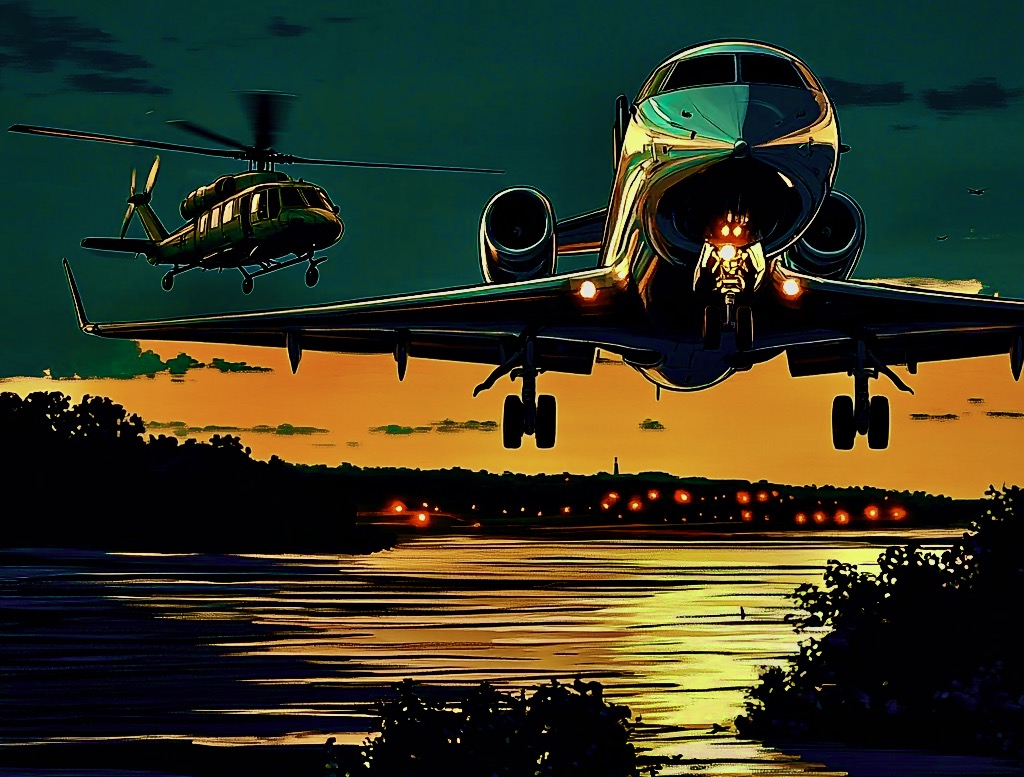 frigid waters.
frigid waters.
All told, 60 passengers, four plane and three chopper crew members perished in the worst US aviation crash in over 20 years. Alas, St. Christopher prayers and Godspeed to the victims and their survivors.
Potomac Crisscrossing.
More specifically, the southbound Army Blackhawk Sikorsky UH-60, directed to a Route 4 corridor along the river’s east bank to avoid commercial aircraft, crossed paths with an American Air subsidiary PSA (American Eagle) Flt. 5342, a twin-engine Bombardier CRJ700 (N529EA), which had been circling to position for landing approach onto Reagan Runway 33, after a 3½ hour flight from Wichita, Kansas.
“PAT25, do you have the CRJ in sight?” So radioed the Reagan tower air traffic controller to the Black Hawk crew, reportedly advising the helicopter to pass behind that CRJ (Canadian regional jetliner). The Army pilot replied, “…the aircraft’s in sight”, requesting ‘visual separation’ to steer clear of the plane—also on a horizontal, but intersecting path. Now, whether the CRJ pilots were duly alerted as to the chopper itself remains uncertain to date.
Moments later, “Did you see that?” gasped the controller to his fellow ATCs; then came “Code Three, crash, crash, crash!” A fiery explosion in the clear night sky, and both aircraft plunged into an icy Potomac, the Bombardier breaking off into several pieces, bodies and belongings strewn across the river depths—not least those of numerous young figure skating champions. That much is known thus far; yet other factors are still open to discovery and interpretation…
Elevation Issue: The High and Low of It.
Early reports have the PSA captain a six-year veteran, his first officer logging two. The Black Hawk crew, on a required annual night evaluation flight, comprised a female captain/co-pilot trainee; instructor pilot with 1k hours of flight time, and a ‘fairly’ seasoned trainer/crew chief. So significant experience would apparently pertain; otherwise, matters get rather murky, as apparently did the prior tower-to-cockpit communication channels.
For starters, Flt. 5342 had been diverted by ATC to shorter Runway 33, apparently due to wind conditions, the jetliner adjusting its landing accordingly. Both aircraft were presently under visual flight rules rather than instrument approach, pilots being responsible for maintaining their own separation from other air traffic via constant line of sight, without more exacting, hard-pressed tower direction. Which does raise the question of whether the two actually saw one another as the plane crossed the copter’s corridor. Or if the Black Hawk did receive the radio message to pass behind the CRJ; whether its altimeter readings were accurate, even if the copter mistakenly spotted a different plane climbing just south of them—as captured in a widely circulated video clip.
Since both the Black Hawk and American Eagle jet were navigating below one thousand feet, two key avionics systems were inoperative at the time. Neither the Bombardier’s Automatic Dependent Surveillance Broadcast (ADS-B with or without Resolution Advisory), nor Traffic Alert and Collision Avoidance System (TCAS) settings were activated. Indeed the copter, on a training mission, may have been flying sans TCAS (even if so equipped) to avoid detection. Moreover its crew  might have been wearing night goggles: monochromatic, limiting their field of vision from a clear eyed 180 to a less than 45-degree arc, likely obscuring the PSA’s running lights.
might have been wearing night goggles: monochromatic, limiting their field of vision from a clear eyed 180 to a less than 45-degree arc, likely obscuring the PSA’s running lights.
In any event, preliminary investigations suggest that the Black Hawk pilot should have been flying along the Route 4 corridor, along the Potomac’s eastern bank, back to Fort Belvoir, VA—at an altitude of between 100 and 200-feet. But the chopper may actually have been at over 300-feet, veering nearly a half-mile off course, at that. Then again, the American Eagle aircraft might have been descending a bit lower than directed, nosing up slightly just before impact. All this will come out in due time, however— ‘black boxes’ having been retrieved intact during rescue-to-recovery efforts.
Another issue centers on Reagan’s control tower itself—that of inadequate ATC staffing. Busy and complex as the D.C. Airspace can be, reports that it is 85% staffed, with 24 of 28 positions filled sparks familiar concerns. Particularly upon learning that with five controllers on duty, one was dismissed early, a single controller left directing both aircraft, ‘Not normal’, said the FAA, given the time of day and traffic volume; such ‘doubling up’ usually being avoided until after 9:30 p.m. at the earliest.
But this ‘overloading’ is symptomatic of an ATC force chronically shorthanded by some 3k controllers nationwide, for 140k positions in 313+ facilities.
‘Confluence of Errors?’
So claim aerospace observers industry pundits, not to mention Congressional types dependent on convenient nearby Reagan National—even though some of the latter have instead called for closing the overcrowded airport since 2001.
The FAA (under temporary Administrator, Chris Rocheleau) and Jennifer Homendy-Chaired NTSB are tasked with combing the data and voice recordings, examining the wreckage of both aircraft pulled from cold, dark waters—initial reports due within 30 days. Meantime, two shorter Reagan runways are closed for a week, Army helicopters restricted from D.C. airspace until further notice.
NTSB are tasked with combing the data and voice recordings, examining the wreckage of both aircraft pulled from cold, dark waters—initial reports due within 30 days. Meantime, two shorter Reagan runways are closed for a week, Army helicopters restricted from D.C. airspace until further notice.
One hell of a start for newbie Transportation Secretary, Sean Duffy, just days into the job—especially while his boss has been casting blame and conspiracies from the get-go. And next a medical transport jet crashed in a Philadelphia neighborhood just after takeoff. Then a NOTAM technical snafu hit the FAA and hobbled air traffic anew over the weekend, scrambling DOT cadre blaming an antiquated warning system for the many “residual (flight) delays”.
Following on February 5, the wingtip of Japan Airlines Flight JL68, a 787-9 Dreamliner arriving from Narita Airport, clipped the tail of parked Delta Flight 1921, a 737-800, at Sea-Tac International. No injuries were reported but passengers on both damaged aircraft deplaned mid morning, some 100 flights subsequently cancelled or delayed.
By turns, some 21 passengers were injured, but there were no fatalities February 17 on Delta Airlines/Endeavor Flight 4839. The Bombardier CRJ900 regional twin jet, carrying 80 passengers and crew from Minneapolis/St. Paul, hard landed at Toronto Pearson International Airport, flipping over, shedding wings and tail under extreme winter conditions. Shortly after a harrowing, yet miraculous evacuation of the belly-up fuselage, US FAA and NTSB investigators headed north to aiding in post-crash inquiries/analysis.
So it remains to be seen whether the rookie DOT administrator is all over the reckoning of this tragedy and its ramifications, or simply spins wheels, being ‘efficiently’ content to sit on his belt-tightened duff.
(Update:) When in fact Duffer’s first remedial decision was to fire an understaffed, overtaxed FAA workforce by the hundreds. Dodgy shot, Duff, evidently aiming for personal servitude over air travel safety—take a penalty stroke out of petty cash. Or is a timely mulligan in order? (MTC…)
![]()
Turmoil Aground, Turbulence Aloft.
(9/12/24)—Delta Skelter. Beyond Delta Airlines’ recent CrowdStrike tech debacle, the Atlanta-based ‘Big Four’ US carrier has logged a string of recent mishaps.
Detailing a De-Tailing…
The latest was the literal de-tailing of a smaller Delta subsidiary aircraft by a heavyweight Delta A350 Tuesday morning at Hartsfield-Jackson Atlanta International Airport. Both planes were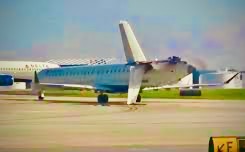 departing busy ATL tarmacs for adjacent taxiways when the wingtip of a Tokyo-bound Airbus, Flight DL-295 with 221 passengers, clipped the vertical tail section of Flight DL-5526, a Bombardier CRJ-900 regional jet headed for Lafayette, Louisiana with 56 travelers onboard.
departing busy ATL tarmacs for adjacent taxiways when the wingtip of a Tokyo-bound Airbus, Flight DL-295 with 221 passengers, clipped the vertical tail section of Flight DL-5526, a Bombardier CRJ-900 regional jet headed for Lafayette, Louisiana with 56 travelers onboard.
The A350 completely wing-sheared Bombardier’s tail section like sliced prosciutto, leaving its entire severed assembly tumbling sideways to the taxiway pavement—that massive wing also sustaining significant damage in the accident. No injuries were reported, but ruffled passengers were 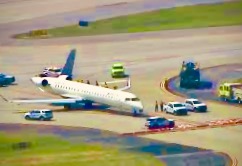 returned to terminal gates for re-routing to rather later Delta flights. The FAA and NTSB are investigating hows and whys of such a scary dissevering tail incident, occurring midmorning at the busiest US airport (in passenger traffic): namely a shave way too close to the yaw.
returned to terminal gates for re-routing to rather later Delta flights. The FAA and NTSB are investigating hows and whys of such a scary dissevering tail incident, occurring midmorning at the busiest US airport (in passenger traffic): namely a shave way too close to the yaw.
This, after a late-June Flight DL-475 Boston-to-San Francisco run, its Airbus A-321-200Neo turning back when one engine blew during takeoff. Barely two days later, Flight DL-916 from Atlanta to San Francisco suffered engine failure (due to oil/pressure loss), the aged Boeing 757-200 aircraft diverting to Salt Lake City.
Thereabouts (June 20-21), Flight DL-92, a 767-300ER from New York to Berlin faced an anti-skid brake problem over British airspace, necessitating an extra-long runway landing at Berlin Brandenburg Airport Willy Brandt. Then Flight DL-1245, an Airbus A320 en route to Boston, returned to West Palm Beach, Florida with a left engine fire shortly following takeoff.
Bloody earful: Most recently, a Delta Flight DL1203, headed for Portland, Oregon from Salt Lake City on September 15 experienced cabin depressurization as it approached 10,000-feet. The Boeing 737-900, a 5.7 year-old narrow body, had passengers’ ears popping and splitting some 20 minutes into the flight, in some cases causing bleeding from earholes and noses. The flight leveled off, then returned to SLC with a hard landing and heavy braking. Ouch…but no serious injuries were otherwise reported.
Just the same, United Airlines has fared little better of late, Flight 1273—a 24-year-old Boeing 777-200 bound for Maui, Hawai’i from San Francisco, returned to SFO some 75 minutes after takeoff with an undefined ‘maintenance issue’. Flight UA-507, bound for Rome from San Francisco on August 14, diverted to Sacramento with an unspecified mechanical problem. Just to name a few…
Something Stirring In the Air.
In the wake of Singapore Airlines Flight SQ321’s horrific bout with extreme turbulence last May 21—upon which its London-to-Singapore 777-300ER emergency diverted to Bangkok—has come this rocky slipstream:
A late-August United Airlines Flight 1196, Cancun, Mexico-to-Chicago with 179 aboard, suffered at least seven injuries when the 737 encountered severe turbulence over Louisiana, bailing to Memphis, Tennessee. Earlier on, an Austrian Airlines A320 flying from Spain to Vienna suffered a severely broken nose cap (radome) and cracked cockpit windows during a turbulent hailstorm. Some five days after the Singapore Air ordeal, a Qatar Airlines flight QR-017 from Doha to Iceland on a 787 Dreamliner, tussled with major turbulence over Turkey.
As to that Singapore incident, Flight SQ321 suddenly met with extreme turbulence at some 37,000-feet over Irrawaddy Basin in southern Myannmar. A rapid change in the plane’s vertical rate—updrafting nearly 400-feet without warning, autopilot pushing it back down much the  same—lasted well over one minute, and prompted the pilot to declare a medical emergency, quickly diverting on speed-brake controlled descent to Bangkok.
same—lasted well over one minute, and prompted the pilot to declare a medical emergency, quickly diverting on speed-brake controlled descent to Bangkok.
Amid it all, a 73-year-old man died of an apparent heart attack, and over 100 other passengers were injured (eventually offered compensated by the carrier: $10k to 25k depending on severity, refunds overall). Upon inspection at Bangkok’s Suvarnabhumi Airport, the 777 aircraft was a frightening picture of gashed cabin walls, dangling ceiling panels and gas masks, overhead bins sprung open and luggage/personal items strewn about.
Particularly vulnerable were passengers who had unbuckled their seatbelts inflight, many flung around the cabin, if not launched toward the tattered ceiling at a G-force of 3.85 (e.g., 300-450 pounds per 200 lb. individual) in every direction. Flight safety experts consider this one of the worst turbulence charged accidents in commercial aviation history.
What It Is…
More broadly, turbulence is caused by clashing parcels of air moving at markedly different speeds. It is estimated to have been related to 1/3rd of airline accidents between 2009-2018, since worsening and becoming more frequent as global weather patterns are altered by climate change.
Geographically, air turbulence appears to be most intense over Africa, South Asia and the South Atlantic Ocean. In the Western Hemisphere, it develops primarily over mountainous regions—of a piece with tornadoes and straighter line, hurricane-like windstorms (e.g., derechos) in the territorial US.
Aircraft hitting a turbulent air pocket can begin drastically yo-yoing, wings flapping like seabirds, cabins going frighteningly Cuisinart in a matter of seconds, lasting for minutes on end—not least in even fiercer clear air turbulence.
Be that as it may, best we can do about it for now is hold tight, buckle up, then chill and hope like blazes to fly right, wherever we may be headed. For while the taxi/takeoffs might get touchier these days—close shaves edging closer—ground errors should ultimately be preventable. On the other hand, turbulence can ever thrash us out of thin air. (MTC…)
![]()
Fearsome Foursome.
(4/23/24)—Throttled and Fourstalled: Picture a fully boarded international flight revving toward rotation down a major US runway, only to be hit by a 4×4: that is, its pilots spotted something else entering the same runway dead ahead of them.
Which is precisely what happened to Swiss Air 17K Heavy, an Airbus 330-300 bound for Zurich April 17, after it was tower cleared for takeoff on Runway 4 at about 5 p.m., JFK International Airport time. Swiss 17K Heavy rejecting takeoff,” tensely radioed the jetliner’s flight crew, “traffic on the runway.” With that, the Airbus throttled down mid-runway, aborting plans for liftoff altogether—before being instructed by the tower to exit onto Runway 31L.
By ‘traffic’, Swiss Air’s captain meant another aircraft entering from a taxiway, right to left, further down Runway 4L. Only it wasn’t just one other plane, Delta Fight 29, there were three others nosing out from separate taxiways even further down—all directed by ground control to cross Runway 17 (American Airlines Flight 2246, Republican 5752 and Delta 420) in short order.
cross Runway 17 (American Airlines Flight 2246, Republican 5752 and Delta 420) in short order.
Situational Unawareness?
Communications breakdown, one hand jobbing the other? What was, or wasn’t, going on between the air traffic and ground controllers this time?☟ One controller not knowing what the other is doing, moving four aircraft across an active runway while the two are not talking to each other is totally unacceptable, says one veteran airline pilot/pundit, adding it indicates a ‘special level of stress’ among the ATCs.
Once again, no injuries nor aircraft damage were reported here. But perhaps most troubling about this fearful four-misplay was that it took the Swiss Air pilots themselves to spot JFK’s controller errors. Swiss Air officials soon praised “…(the) high level of situational awareness and quick reaction of our flight crew, (thus) a potentially dangerous (incursion) was quickly de-escalated.”
Yet again the FAA is investigating this latest risky ‘near-miss’. In any case, four-of-a-kind clearly doesn’t beat playing to a runway straight, whether in one hand or the other. (MTC…)☟
![]()
Cross Fits.
(4/19/24)—Southwest stop! JetBlue 1554 stop!! What trained professional traffic controllers wouldn’t cry bloody murder when the planes they’re directing are rolling so close to a catastrophic Dutch crunch?
But that is precisely just what happened at Ronald Reagan Washington National Airport (DCA) when two jetliners were inadvertently set on a collision course. Because two separate controllers apparently got their orders crossed, if not their wires, creating a ‘near miss’ runway drama amid the early morning rush.
Specifically, one tower air traffic controller cleared JetBlue Airways Flight 1554, a Boston-bound Embraer 190 for takeoff, which immediately began accelerating to 35 mph on Runway 4. Meanwhile a ground controller instructed Southwest Airlines Flight 2937, an Orlando-bound 737 MAX-8 to taxi across Runway 4. The tower controllers frantically recognized the error of their ways within 30 seconds, 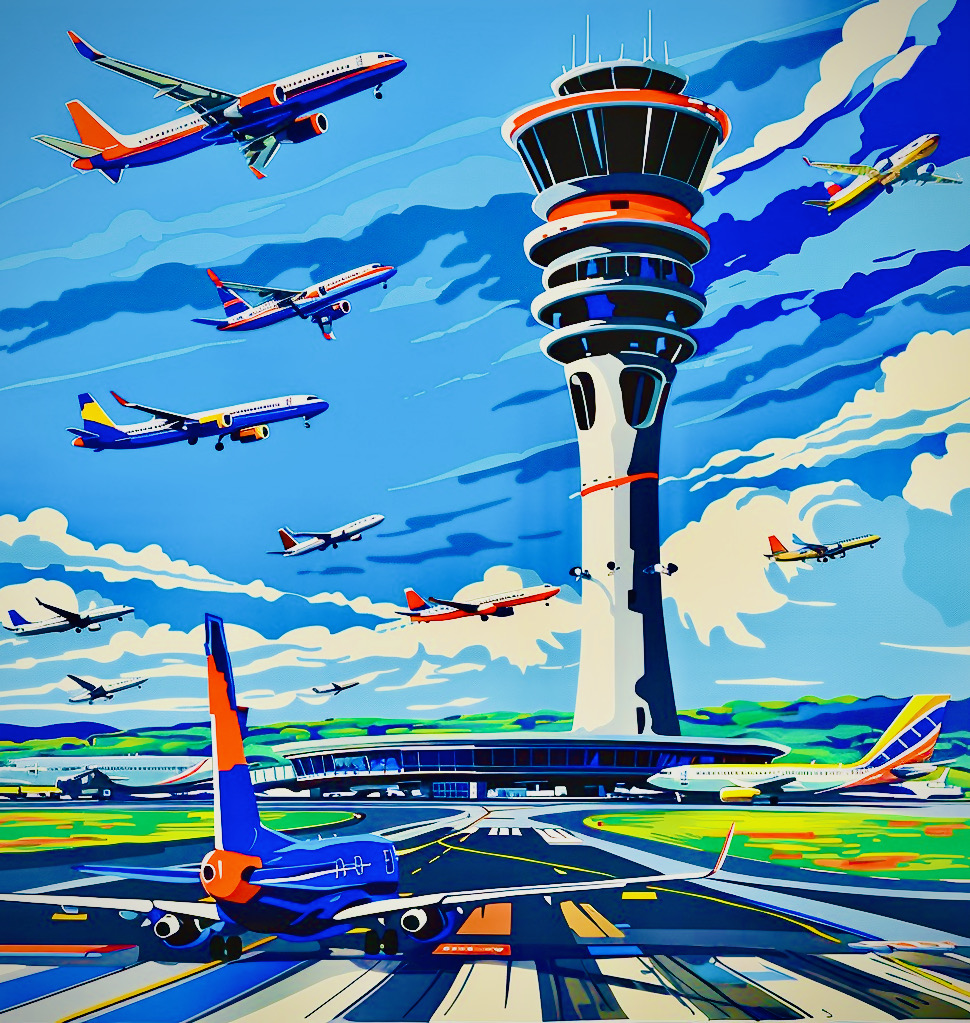 screaming at both cockpits to cease movement post haste.
screaming at both cockpits to cease movement post haste.
Where did that leave packed aircraft? Southwest 2937 stopped some 65 feet short of actually crossing the runway, albeit with its forward fuselage nosing out. JetBlue 1554 pulled up some 300 feet away—no injuries being reported on either plane. The Southwest 737 taxied ahead toward a second runway, soon taking off for Orlando; however JetBlue’s flight, takeoff having been aborted, departed later for Boston Logan International Airport.
Controller misread, yet another case of harried ATC direction gone sideways? There were 1,760 such US runway incursions in 2023, with a total of 685 in airports nationwide so far this year (source: FAA). Little wonder the aviation agency is investigating this Reagan near mishap, and moving to ease air traffic controller fatigue beyond slowing traffic in understaffed towers. Meanwhile it is pushing to fill more current ATC vacancies, what with only three of 313 air traffic control facilities said to be sufficiently staffed these busy days.
Moreover, the FAA is issuing a directive to increase controller break-time to 10 hours between normal shifts, 12 hours for overnighters, and eliminate grueling five shift/four day/three day off stretches known at “rattlers.” Kibitzing Washington politicos further lay blame on Reagan National’s congested, 1930’s-era intersecting runways, designed more for biplanes than Boeing fan jets.
At any rate, today’s fully booked airliners, indeed all commercial and private aircraft, really have to stop meeting like this. Even so, an instrumental visionary approach to safer airstrips and skies is likely to take far more than fitful federal ‘trust, but verify’ correctives flashing across overworked radar screens. Copy that…(MTC…)![]()
FAAl-Safe?
(2/10/24)—Check, recheck or be checked: While missing flight connections can be extremely frustrating, missing door plug bolts and mis-drilled fuselage holes can prove downright fatal.
Which likely weighed heavily on the mind of newbie Federal Aviation Administration head, Michael Whitaker as he recently testified before the US House Transportation and Infrastructure Aviation Subcommittee.
Top of mind questions in the FAAce-Time session: Has his agency been too soft on the Boeing Company? 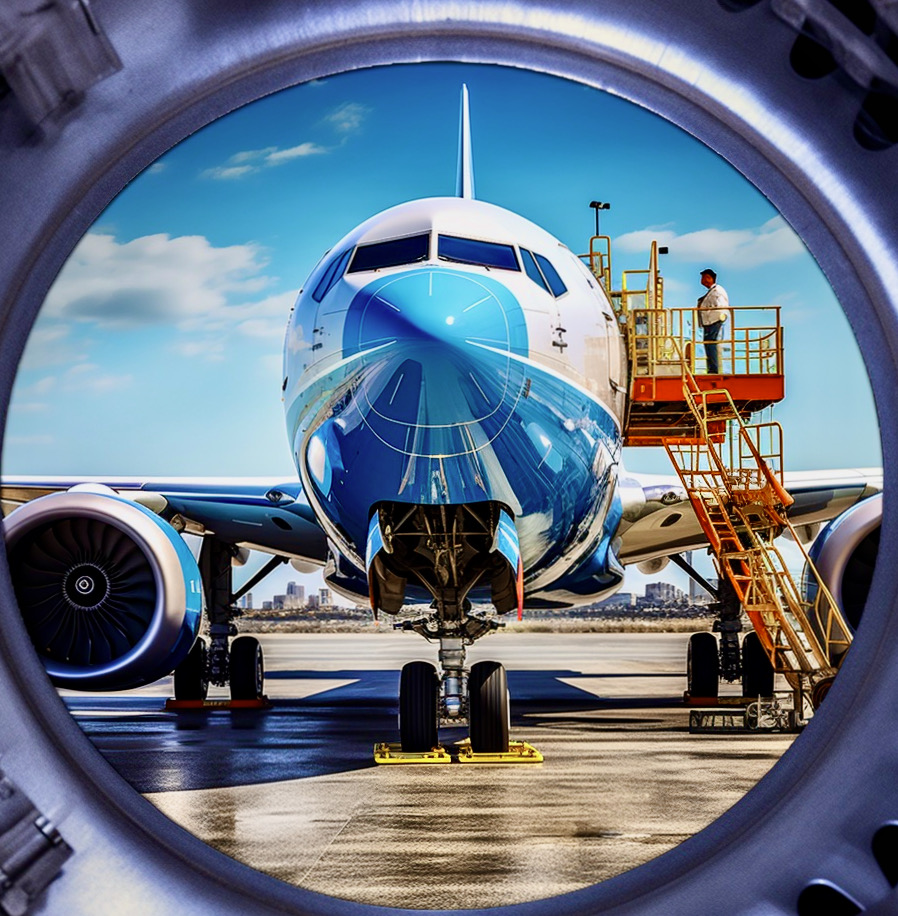 What’s going on with the planemaker’s production (Renton WA to Spirit AeroSystems in Wichita, KS), and what’s wrong with its 737 MAX-9s? Whitaker’s own reckoning: “(Our) current system is not working because it is not delivering safe aircraft.” Too many snaps, gaps and mishaps—this, nearly five years after the deadly MAX-8 LionAir and Ethiopian Air crash disasters and MCAS fallout that followed.
What’s going on with the planemaker’s production (Renton WA to Spirit AeroSystems in Wichita, KS), and what’s wrong with its 737 MAX-9s? Whitaker’s own reckoning: “(Our) current system is not working because it is not delivering safe aircraft.” Too many snaps, gaps and mishaps—this, nearly five years after the deadly MAX-8 LionAir and Ethiopian Air crash disasters and MCAS fallout that followed.
His FAAce-saving effort came on the contrails of Alaska Airlines Flight 1282’s MAX-9 door plug fiasco. The panel blowout over Portland, OR triggered a grounding of the entire MAX-9 fleet that only now is being fully lifted nationwide. Images of passengers staring frightfully through an exit-size fuselage hole out to a chilling night sky at 16,000 feet—then of a Portland schoolteacher finding that jettisoned plug in his backyard shrubbery—were but the beginning of this latest, not to mention potentially catastrophic MAX debacle.
FAAce/Plant Magnified.
As FAA, National Transportation Safety Board and Boeing investigators combed the impaired aircraft once it had safely returned to PDX Airport, another picture quickly emerged. What began as an inquiry about four corner fasteners designed to keep the door plug firmly in place (i.e., not shift upward) advanced from panel bolt mystery to bolts gone missing to bolts being alarmingly mishandled altogether.
Seems line workers at Boeing’s Renton assembly plant had been alerted to damaged doorway rivets on the fuselage delivered August 31, and had removed the plug to replace them around 9/1. Trouble was, upon returning the plug panel to its rear-cabin exit door position, they neglected to securely bolt the panel in place. Then a photo attached to an internal shop floor TXT soon proved it, clearly showing at least three bolts missing from the plug frame entirely.
This NTSB discovery came after the agency had already found “contact damage or deformation around certain holes” in that very fuselage. Moreover, holes had been misdrilled on dozens of other ‘tubes’ railed to Renton from former Boeing subsidiary, Spirit AeroSystems in Wichita—while troubled 787 Dreamliner production continued in fits and starts at the planemaker’s South Carolina assembly plant. Incidentally, absolved of responsibility for the doorframe/plug damage was an Oklahoma City contractor (AAR) that had wired some 60 new Alaska MAX-9s for Wi-Fi (from 11/27 to 12/7) as they flew in from Renton.
Otherwise, amid her safety agency’s investigation, NTSB Chief, Jennifer Homendy rued the loss of critical cockpit information on how Alaska’s flight crew initially reacted to the door plug ejection, primarily due to its ‘black box’ voice recorder’s limited memory. What was said, what it sounded like up there, engine/wind noise and all? ’Twas forever gone because today’s CVRs c(r)ap out at two hours—automatically looping, overwriting into the box’s next recording cycle. The NTSB has long pressed the FAA to install 25-hour storage capacity CVR’s on flight decks across the board, but the aviation agency prefers outfitting new aircraft only, at least for now (MTC on that shortly).
FAAcing the Music.
For its part, FAA investigators concluded that the door plug blowout “never should have happened and it 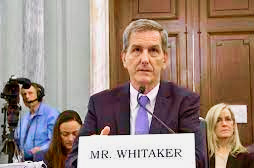 cannot happen again.” Boeing replied, “we are accountable for what happened…and we must do better.”
cannot happen again.” Boeing replied, “we are accountable for what happened…and we must do better.”
Be that as it may, Whitaker also rogered the reality that his aviation agency has long been relying on Boeing’s and other aero industry employees to police their own safety related work. Indeed, whether to spare overloaded FAA employees or save federal money, the agency has enabled powerful aerospace manufacturing facilities to become their own shop floor watchdogs.
In Boeing’s case, its Renton plant reportedly had but eight inspectors overseeing some 12,000 employees in 2023—the FAA admitting it has not been adequately serving as the planemaker’s quality inspectors. This, as Boeing executives have been pressuring its workers to get 737 MAX-9s out the door—to where the FAA’s inspectors’ union claims new planes sometimes leave the shop floor without federal inspectors examining them at all. Even when the agency sought to conduct a Boeing factory inspection/audit, doors opened only after months of approval negotiations. ‘Nothing but an annoying distraction’, complained some in the aviation company’s vast circles and spheres.
More FAAcial Recognition?
Accordingly, Administrator Whitaker testified that the FAA must increase direct, heightened oversight of the aerospace suppliers in general, Boeing in particular. Although the planemaker has noted a 20% increase in production line inspectors since 2019, the aviation agency now looks to boost FAA and third-party inspectors in Renton by two dozen—plus by a half-dozen at the Spirit AeroSystems plant.
The agency also aims to tighten the regulatory screws on Boeing’s authority to conduct final safety checks  and grant airworthiness certification on the FAA’s behalf—while throttling the company’s suspect ‘process monitoring/ surveillance’ and statistical sampling methodologies. Moreover, the MAX-chastened FAA wants Boeing to develop a voluntary employee reporting system regarding possible safety issues; to slow its monthly Renton rollouts from 42-50 planes to 38, and forget about production line expansion to its former 777 assembly plant up in Everett, WA.
and grant airworthiness certification on the FAA’s behalf—while throttling the company’s suspect ‘process monitoring/ surveillance’ and statistical sampling methodologies. Moreover, the MAX-chastened FAA wants Boeing to develop a voluntary employee reporting system regarding possible safety issues; to slow its monthly Renton rollouts from 42-50 planes to 38, and forget about production line expansion to its former 777 assembly plant up in Everett, WA.
So goes the newly rigorous FAA watch under Michael Whitaker thus far, albeit with heedful Congressional ‘checkmates’ up on Capitol Hill. All the same, Boeing must fly forward under a nimbus cloud of quality and quantity challenges—facing onerous revenue cuts, soaring costs and a preying rival in Airbus SE. It being flush with aircraft orders, albeit straining to fulfill them, having designs for an entirely new clean, green variant already in the works. Toulouse La Trek?!
What’s it to us travelers? Here’s a little something in the air to choose on: hundreds of 737 MAX airliners remain in operation, having been certified prior to such ‘heightened’ FAA airworthiness scrutiny and compliance.
Just sayin’…then again, we’re likely to blow their doors off anyway over the busy months ahead. Meaning, ‘if it ain’t blowin’, we’re still goin’. (MTC…)
![]()
Towering Tensions.
(12/2023)—What’s going on up there? Are today’s air traffic controllers fully under control? After all, they do hold travelers’ lives in their hands, across their screens, right?
Yet recent US media reports convey instances of ATC drinking, drugging, sleeping and slugging it out on the job—even tail-dragging exhaustion, panic attacks—not to mention scattered suicide attempts. This, as 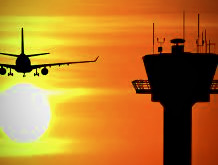 controllers are the critical ground-to-cockpit bulwark against air crash disasters, with thousands of passenger/crew lives in the balance at any given moment.
controllers are the critical ground-to-cockpit bulwark against air crash disasters, with thousands of passenger/crew lives in the balance at any given moment.
More specifically, the Federal Aviation Agency logged more than 500 ‘significant’ controller lapses by September 30, fiscal year’s end—a 65% increase over 2022. Meanwhile, air traffic controllers themselves filed hundreds of complaints to the FAA, listing staffing shortages, mental health issues, outdated equipment and deteriorating facilities—radar screens to lightbulbs. Thus making for ‘unsustainable’ system risk of ‘near miss’ taxiway/runway incursions, let alone inflight collisions; just ask the National Transportation Safety Board (NTSB) about it.
ATCs further cite grueling overtime, six-day workweeks in at least 40% of towers, leading to distracted, demoralized controllers increasingly vulnerable to judgment/communication errors, often wary of revealing fatigue, much less psychological stresses, fearful of failing FAA medical clearances.
Copy: Over and Out.
For its part, the FAA “…maintains the safest, most complex and busiest airspace in the world…”, but allows as how the system does need many more qualified air traffic controllers these days. The aviation agency  also notes that tower staffing has been problematic since the Reagan Administration’s wholesale massacre of striking ATCs in the early 1980s—and has ever since struggled to keep up with slipstreaming retirements, mainly at the mandatory age of 56.
also notes that tower staffing has been problematic since the Reagan Administration’s wholesale massacre of striking ATCs in the early 1980s—and has ever since struggled to keep up with slipstreaming retirements, mainly at the mandatory age of 56.
Now FAA records show that the total controller workforce shrank 9% from 2011-2022, just as air traffic has grown exponentially. Moreover, 400 (10% of) senior ATCs are projected to retire this fiscal year alone. Accordingly, the agency has sought $117m from Congress to hire and train some 1,800 new controllers.
Whether that number would sufficiently stanch the towering bloodshed remains to be seen. But meantime, the tensions above are likely to continue crossing controller touchscreens, and Vamigré screens withal, as we keep track of what’s going on up there. (MMTC…)
![]()
Close Calls, Shroomer Squalls.
(10/23/23)—It’s been a harrowing week around Portland International Airport:
First, an Alaska Airlines Flight 1299 attempting to land on runway 28 Left did a go-around in the face of heavy wind and rain last Monday, turning toward a Sky West 3978 flight that had just taken off from parallel runway 28 Right. The two planes came within 100 vertical feet of one another—Flight 1299 diverting to Roberts Field in Redmond, Oregon; 3978 landing at Sea Tac International Airport as intended. It was at least the tenth such close-call incident so far in 2023 (according to FAA records).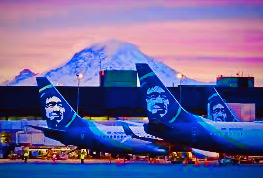
(Updated 10/24/23)—Then comes the ‘jump seat occupant’-turned-jumpy attempted murderer. Seems four minutes into Alaska Airlines flight 2059—which departed Everett, Washington’s Paine Field Sunday night bound for San Francisco with 80 passengers—turbulence threatened to overtake the cockpit—and not the usual atmospheric kind.
For the Embraer 175 regional jet operated by Alaska’s Horizon Air also had an off-duty pilot joining the two-man crew, deadheading home to the Bay Area (a common professional flight-deck courtesy) after his latest (October 19th) flight. However the hitchhiking Alaska pilot fomented an alarmingly different flight plan in that cockpit jump seat, directly behind the pilots: namely killing the plane’s two engines at cruising altitude—smacking of aviator suicide induced crashes like GermanWings’ (Andreas Lubitz, 2015) and EgyptAir (1990).
According to Alaska Airlines officials, Joseph David Emerson, 44, is alleged to have thrown his headset across the cockpit and suddenly reached overhead to shut down engine power by pulling the Embraer’s fire extinguisher T-handles, closing wing valves to shut off fuel lines, as designed into the aircraft’s fire suppression system. Only a quick crew response to reset the handles and restore fuel flow to stem engine starvation managed to save the flight.
One pilot then wrestled with Emerson for nearly 90 seconds, grabbing his wrists, restraining and purging him from the cockpit, flight attendants securing him aft cabin. The suspect squalled that “they needed to cuff (him) or it’s going to be bad…that (he) was not okay.” So flex cuffed, Emerson was subsequently heard saying he had done “magic (psychedelic) mushrooms” two days before, and was having a nervous breakdown. That he’d been depressed for months, nay years; had not slept for 48 hours, and tried to pull the T-handles because “…I thought I was dreaming and just wanna wake up…and the pilots weren’t paying attention to what was going on…”—further admitting he had “…messed everything up and tried to kill everybody.”
In any event, the pilots immediately notified air traffic controllers of an onboard “credible security threat” due to a cockpit disturbance, but that a “mentally disturbed” suspect had been subdued, constrained, albeit after he attempted to open an emergency door. Diverted to Portland, Oregon, the crew requested a law enforcement presence upon landing. Meanwhile flight attendants simply informed passengers of a “medical emergency” on board, and that the aircraft had to land forthwith.
Bummer Trip Forestalled.
Once safely parked and evacuated at PDX, Alaska 2059’s passengers boarded later flights—with no injuries otherwise being reported. Portland authorities immediately detained the “jump seat occupant”, charging him with 83 counts of attempted murder and reckless endangerment (since reduced from felonies to misdemeanors), plus one count of endangering an aircraft. The FBI is also investigating, “assuring the traveling public there is no continuing threat…(and 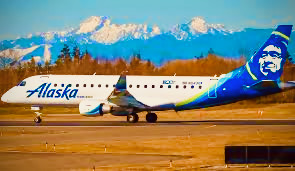 that) the incident was not connected in any way, shape or form to current world events.” Nevertheless, federal charges against Emerson of interfering with a flight crew swiftly followed.
that) the incident was not connected in any way, shape or form to current world events.” Nevertheless, federal charges against Emerson of interfering with a flight crew swiftly followed.
As FAA records have it, Emerson, a 20-year cockpit veteran from Pleasant Hill, California, is Airline Transport Pilot certified to fly the Boeing 737, Airbus A320, DeHavilland Dash 8 and Canadair Regional Jet, although not the Embraer ERJ 175 model he had just attempted to bring down in something of a mushroom cloud. But the FAA says his magic mushroom trip disqualifies him for pilot medical certification, and Alaska summarily removed him from service.
Stigma personified, stigma fleshed out: The Federal Aviation Agency doesn’t automatically sack pilots if they are suffering anxiety, depression or other mental health maladies, and are being professionally treated. But psychosis, bipolar and other personality disorders are clearly cerification disqualifiers, as apparently are mind-altering substances like psilocybin.
A 2016 Harvard public health study found that 13% of commercial airline pilots meet clinical depression criteria, 4% reporting suicidal thoughts. Moreover, a 2022 University of North Dakota Aerospace Sciences study found 56% of 3,800 US commercial pilots surveyed avoided health care altogether, 27% withholding health issues/information in written questionaires to medical examiners—mainly for fear of losing their flying certificate and grounding their careers. Self reporting? Flyers will do anything to hide their mental health, insomnia, alcohol and drug problems, says one (tired,) retired UAL pilot, it is taboo territory in airline cockpits worldwide.
Hence, so much for industry pressure to remove the FAA’s two-pilot rule amid today’s commercial pilot shortage. Indeed, if this ‘airbrained’ sabotage effort is any indication of the depths carriers are combing to fill their (overworked) flight decks these days, air travelers best remain mindful of such potential cockpit toxicity. Indeed we insist onboard safety and pilots’ mental fitness don’t take a jump seat to the flight-crew scarcity and hiring scrambles of today. (MTC…)
(Update: 11/1/23)—Cockpitiful Gunplay. This, while a Delta Airlines pilot has been charged in Utah Federal District Court October 18 for interfering with a flight crew. How so? Allegedly, a pistol-packing co-pilot waved his piece at the captain aboard an August 22 flight, threatening to shoot him multiple times 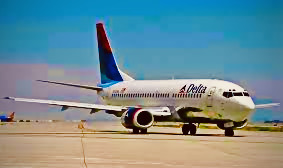 over diverting the plane due to a passenger’s medical emergency. Didn’t come to that, but California-based John Dunn was summarily done in “…for using a dangerous weapon in assaulting and intimidating a crew member.”
over diverting the plane due to a passenger’s medical emergency. Didn’t come to that, but California-based John Dunn was summarily done in “…for using a dangerous weapon in assaulting and intimidating a crew member.”
Delta fired him AZAP, and the FAA revealed he did not have a current medical certificate anyway, let alone firearms recertification (required twice per year). Dunn was carrying as part of a federal flight deck officer program (FFDO), instituted in the wake of 9/11—the idea being pilots can use a gun to “defend against an act of criminal violence and/or air piracy while attempting to gain control of the plane”—TSA covering the costs. But criminal is as criminal does, so Dunn will be arraigned November 16 in greater detail, facing up to 20 years in the slammer. Cockpitiful behavior, all right, if it wasn’t so downflight frightening. (MTC…)
![]()
re: FAAlures: Check, Double Check?
(12/16/23)—Beyond concern over the quality and authenticity of aircraft replacement parts, come sparks of contention regarding the safety inspection for potential defects and production deficiencies. ☟
Of primary consideration here is supervised- versus self-inspection—the focus being on manufacturing suppliers of key fuselage components and their proper assembly. Bustling, if not beleaguered planemakers such as Boeing are said to be using self-inspection on a modest percentage of small tasks as a means of streamlining production, particularly amid shortages of shop workers and qualified mechanics.
Such assembly floor and tarmac ‘selfies’ (e.g., by workers/mechanics) are said to be conducted “…under 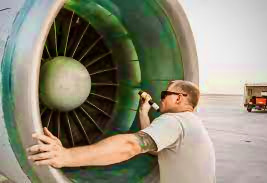 appropriate oversight and (quality) controls communicated to the FAA.” That any quality risks are mitigated through multilayers of safety checks and supervision. The company adds that X-ray, ultrasonic testing and laser scanning are employed to detect any fit-and-finish shortfalls, with even higher-tech/AI tools and processes on deck.
appropriate oversight and (quality) controls communicated to the FAA.” That any quality risks are mitigated through multilayers of safety checks and supervision. The company adds that X-ray, ultrasonic testing and laser scanning are employed to detect any fit-and-finish shortfalls, with even higher-tech/AI tools and processes on deck.
Wrenching Issues.
Rather, self-inspection means shortsighted cost cutting—and just doesn’t fly, say union reps from the International Association of Machinists and Aerospace Workers. “You have to have a redundant system,” holds the IAM, “It’s important to have a (designated) inspector…an (experienced) second set of eyes (to) make sure the work is done appropriately…in an industry with no margin for error.” And the FAA appears to concur, with the 737 MAX quality-control debacle likely fresh in mind—along with news that Boeing rival Airbus must ground more than 600 planes in 2024 due to manufacturing problems with Pratt & Whitney jet engines.
Nevertheless, US air travel is currently safer than ever, some 10bn passengers carried without a fatal crash for the last 14 years—tech advances in flight data analysis, as well as flight-crew, mechanics and air traffic controller tracking ever more penetrating.
Still, may the eyes have it, for two takes are arguably better than one. (MTC…)
![]()
re: FAAlures: Headed For Parts Unknown?
☟(4/19/23)—Do rising costs and supply chain constraints have the aerospace industry hitting the bargain bins?
Recent media accounts reveal that more and more airlines and repair/rebuild facilities in North 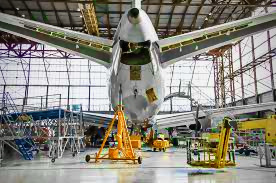 America are looking to generic/off brand and used replacement parts. The payoff is serviceable materials (not necessarily from the original manufacturer) that cost 20-40% less than brand-name list.
America are looking to generic/off brand and used replacement parts. The payoff is serviceable materials (not necessarily from the original manufacturer) that cost 20-40% less than brand-name list.
Second-Hand Screws?
This knock-off/retread market is still but a fraction (2-3%) of the $35bn spent annually for commercial aircraft repairs, but such alternative sales are growing rapidly in today’s high-flying post-pandemic environment. Industry estimates are of that $35bn yearly expenditure, $5bn goes to used parts, $725m to generic components, all of which are typically cheaper and easier to acquire.
Nevertheless, these substitute/indy parts and components must be deemed safe and certified by the  FAA (uh-huh). Still, airlines and repair/overhaul shops are scouring to find parts (engine and otherwise) wherever, anyway they can—including tearing down a patchy supply of aging and/or retired planes that more likely as not have seen bluer skies.
FAA (uh-huh). Still, airlines and repair/overhaul shops are scouring to find parts (engine and otherwise) wherever, anyway they can—including tearing down a patchy supply of aging and/or retired planes that more likely as not have seen bluer skies.
Safe to say, it remains to be seen whether this potential downdraft of industry maintenance standards becomes a wrenching race to the bottom of the bins.
Meantime, hand me that whatchamacallit—right, the one over there from who knows where…(MTC…)
FAAlures: A-SS On The Line?
(3/17/23)—Rolling an unlucky seven (counting the latest close-call incident at Ronald Reagan National Airport☟), the Federal Aviation Administration recently hosted an ‘urgent’ Air-Safety Summit to address some systemic ‘holes’.
But seriously, in the face of seven potentially catastrophic runway mishaps nationwide barely three months into 2023, Acting FAA Administrator Billy Nolan—who announced (4/23/23) he will be leaving his ‘interim’ post this summer—chaired the first ’emergency’ session of the agency’s annual Air-Safety Summit in 14 years, according to network news reports.
Feeling the runaway runway heat, Nolan issued a “call to action”, gathering over 200 airline industry leaders, government officials and air safety experts in McLean, VA March 15 to discuss the current air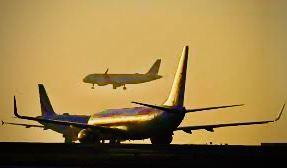 traffic system, airport/ground operations and other general aviation concerns. “There is no question that aviation is amazingly safe…that the system is sound,” Nolan said, playing catch-up in his opening statement—before copping that there are pressures within necessitating sweeping air safety review.
traffic system, airport/ground operations and other general aviation concerns. “There is no question that aviation is amazingly safe…that the system is sound,” Nolan said, playing catch-up in his opening statement—before copping that there are pressures within necessitating sweeping air safety review.
Transportation Secretary Pete Buttigieg agreed, calling the escalating runway incursions “deeply troubling”, given that such serious incidents average between four and ten per year. Including lesser incursions, the FAA totals upwards of 670 this year so far, after 1,732 in 2022, 1,753 in 2019. National Transportation Safety Board (NTSB) Chairwoman Jennifer Homendy added that, “the absence of a fatality or an accident doesn’t mean presence of safety.” Others asserted that close calls and near misses should be seen as actual accidents.
Close, But Not So Far…
Yet these seven near-misses are but a fraction of the 45k US flights taking off every day, airline leaders note, and that there have been no commercial US flight fatalities since 2009. They maintain carriers are still recovering and recouping from a trying three-year pandemic period that triggered revenue collapses, massive layoffs and early retirements industrywide. The resulting financial strains and workplace disruptions (losing nearly ¼ of all airline workers), now collide with a travel-starved, post-pandemic customer galestorm.
Thus caught with their wing flaps down, carriers are desperately ramping up hiring, too often working with gate and ground service newbies who are under experienced and instantly over stressed. Severe shortages in the flight crew and attendant ranks even more critically affect airline scheduling and capacity: indeed, qualified commercial pilots are scant and scarce at best, with nearly 50% of current pilots reaching mandatory retirement age by 2039. And what are the safety implications of getting 15-18k replacement cockpit trainees up to speed through 2024?
On the federal side, how does this pressure to get passenger aircraft in and out of busy airports as quickly as possible fly with some 1,200 fewer air traffic control staffers in the nation’s towers than a decade ago? And incidentally, what is going on with FAA Administrator nominee Phil Washington’s confirmation?
(3/25/23)—Turns out that under intense scrutiny by GOP lawmakers who questioned his credentials and background to lead the aviation agency at such a critical time, current CEO of Denver International Airport Phillip A. Washington has withdrawn from consideration. His lack of actual aviation experience (limited to prior transportation authority roles in Regional Denver and Metro Los Angeles), and alleged connection to some no-bid contract corruption under investigation in L.A., gave GOP senators the political cover they needed to doom the Biden Administration nominee’s chances for confirmation. So Billy Nolan continues to act the part of FAA honcho, for better or for worse.
Plenary Wing and Prayer?
Little wonder Nolan asked fresh eyes to question conventional ‘wisdom’, examine the root causes and commonalities of today’s air safety holes—namely engaging in efficient real-time information sharing, collaboration and innovation through further panels, workshops and processes. The A-SS’s ultimate 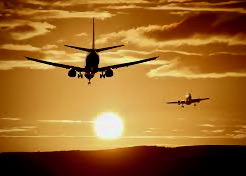 target? Better managing the policies and procedures of safety risk up and down these aviation organizations, and fine-tuning best practices training, aloft to ground—not least focusing on risk models regarding the human factors of cockpit and in-cabin stress and fatigue.
target? Better managing the policies and procedures of safety risk up and down these aviation organizations, and fine-tuning best practices training, aloft to ground—not least focusing on risk models regarding the human factors of cockpit and in-cabin stress and fatigue.
Top of mind was keying on technologies such as Safety Management Systems (SMS) deploying in over 200 of the busiest commercial US airports; refining data collection via the Aviation Information Analysis and Sharing (ASIAS) system, and identifying surface surveillance technology for air traffic control services. Curiously, ASDE-X Taxiway Arrival Prediction (ATAP)—software designed to counter ‘wrong surface events’ by using radar and sensors to determine whether a landing plane is wrongly lined up on a taxiway rather than runway—was not specifically mentioned in the FAA’s final A-SS report.
Still, the Commercial Aviation Safety Group (CASG) is being tasked with reviewing safety trend data; and an Aviation Rulemaking Committee will explore a planned FAA process to expand flight data monitoring, from two to 25 hours of ‘black box’ audio.
But yep, that outta do it, right? Uh-huh, gotta have us more panels, processes and pow-wows…
Meantime, safety first, top priority, safety without fail: that’s essentially A-SS’s mantra, where the summit drew its line. Now let’s see when another odds-on taxi/runway snafu happens to cross it first. (MTC…)
![]()
FAA Crunch Time, NOTAMateur Hour.
(1/30/23)—The FAA has since announced changes in its NOTAM alert/notification system maintenance designed to safeguard against the January 11 outages, which stalled some 11k flights nationwide over a massive nearly two-hour breakdown. Update (5/29/23): Congress passes the NOTAM Improvement Act.
These adjustments are said to involve adding a one-hour delay in linking time to catch any corrupt files or erroneous changes/deletes interfering with backup databases when techies are working to synchronize primary and backup databases. Beyond that, at least two technicians (likely contractors) will heretofore be assigned to these computer hardware/software procedures, including one federal manager.
The agency further explains that its NOTAM system currently comprises two conjoined components, a 30 year-old legacy unit (to be discontinued by mid-2025) and its Federal unit (FNS), whic has been undergoing upgrades since 2019, to be completed by 2030.
But an impatient airline industry is pushing for a speedier revamping of the entire agency, blaming a lack of resources and calling for significantly stronger Congressional support. In response, the House has passed legislation ordering the FAA to form a taskforce of its administrators, plus airport, airline, labor union representatives and aviation safety/cybersecurity experts—charged with improving, advancing alert and other agency systems.
So we’ll see if the new NOTAM guardrails are notification of vital modernizations to come. (MTC…)
![]()
WingDing au Deux.
(2/15/23)—Following far too closely for comfort in the wake of a JetBlue flight nicking a nearby airliner on departure from JFK ☟, United Airlines Flight 2135 to Orlando did the latest wing-clip job today on a neighboring jetliner. In this case, UAL’s 757-200 was taxiing away from the gate at Newark Liberty International Airport. Then comes the shuttle bus giving a towed American Airlines A321 jetliner something of a little nose job in a ‘low-speed collision’ at LAX, injuring five. In its wake, reports are a taxiing United Airlines 777 ’heavy’ jetliner nearly crossed runway paths with a landing Kamaka Air Cessna 208B Super Cargomaster at Honolulu’s Daniel K. Inouye International Airport on January 23—seems like a ‘close-call virus’ is spreading by land and air…
The latest incident being at Hollywood-Burbank Airport (2/22/23) where a landing Mesa Airlines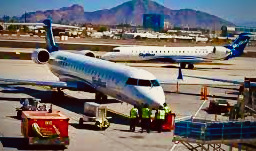 CRJ900 did a sudden pilot-initiated climb-out to avoid a Sky West Airlines Embraer E75 taking off from the very same runway. Mesa’s landing aborted, the Sky West plane continued its departure—albeit with a (Bob) Hope and a prayer, given that this was the 4th such near miss already this year…
CRJ900 did a sudden pilot-initiated climb-out to avoid a Sky West Airlines Embraer E75 taking off from the very same runway. Mesa’s landing aborted, the Sky West plane continued its departure—albeit with a (Bob) Hope and a prayer, given that this was the 4th such near miss already this year…
✈️ Mere days later, another near miss, this time at Boston’s Logan Airport. Early Monday evening (2/27/23), a landing JetBlue E190 initiated an evasive climb-out action to avoid a Lear Jet 60 rolling out for takeoff without clearance on intersecting Runway 9. JetBlue Flight 206’s ‘go-around’ tacked nearly 15 minutes onto the Nashville run, before landing without further incident on RWY 4A. The latest: Republic Flight 4736 turn onto the wrong runway at Reagan Washington National Airport (3/7/23), in front of United Airlines 2003, which had just cleared for takeoff. “Cancelled clearance! Cancelled Clearance,” cried air traffic controllers: fortunately again no injuries or damaged in this seventh runway incursion barely into the third month of 2023.
(3/5/23)—Another day at Boston’s Logan Airport, another disturbing wing-tipping affair: in this case involving two United Airlines jetliners. The ‘slow speed’ tarmac collision occurred when one departing plane was being shunted backwards away from the gate, its wing tip brushing against a neighboring aircraft’s rear tail horizontal stabilizer. Passengers from both planes were evacuated, and promptly transferred to other flights—so no simple touch-and-goes were going on here either. Although no injuries were reported, nor significant damage to the aircraft involved, FAA and NTSB investigators are at it yet again, albeit with their many retirements, other staff shortages in the crosshairs—without a permanent FAA administrator since April 20, 2022, time ticking away…
Tower Vacuum.
(2/10/23)—Closer yet came the brain fart of an air traffic controller at Austin-Bergstrom International Airport Saturday morning that had a Southwest Airlines 737 bound for Cancun cleared to takeoff on Runway 18 Left. Problem was, a FedEx 767 cargo jet was cleared for landing mere moments earlier 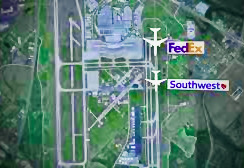 on…Runway 18 Left. With the freighter ATC-directed to all but piggy back the accelerating SWA passenger plane from some three miles out, sanity radioed in and the cargo crew aborted its landing at barely 75-foot altitude. As it happened, the 767 ‘heavy’ came within 1,000 feet of SWA’s ass end, suddenly climbing less than 100 feet above the 737, narrowly avoiding a disastrous runway collision.
on…Runway 18 Left. With the freighter ATC-directed to all but piggy back the accelerating SWA passenger plane from some three miles out, sanity radioed in and the cargo crew aborted its landing at barely 75-foot altitude. As it happened, the 767 ‘heavy’ came within 1,000 feet of SWA’s ass end, suddenly climbing less than 100 feet above the 737, narrowly avoiding a disastrous runway collision.
SWA Flight 708 safely completed its takeoff to Mexico as the freighter peeled away to its left, circling to land strictly solo 12 minutes later. Aviation observers attribute this empty-headed tower instruction to an ever increasing pace of airport operations, too-often overwhelming ATCs. While the National Transportation Safety Board (NTSB) has initiated its investigation of this latest close-shave overflying incident—sifting through the granular data, as it were. Given that the FAA has logged 14 such ‘close calls’ over the past decade, Vamigré to crews and towers: You have to quit meeting like this, over…(MTC…)
Canary In a Cold Mind.
✈️ Update (2/11/23)—Since having resisted testifying at this NTSB probe, the three American Airlines pilots involved in the JFK ‘close call’ (see below) have since been subpoenaed to appear before the board within seven days for audio recorded/court reporter transcribed interviews, which Air Line Pilots Association (ALPA) union reps are challenging as unnecessary and unfair, particularly the video part. Likely at issue is the American 777 crew’s disobeying an ATC directive to turn right and cross Runway 31L, instead bearing left, straight across toward 4L in front of Delta’s speeding 737—a ‘possible pilot deviation’—until controllers emphatically ordered the heavy A/A jet to hold short and Delta to ‘cancel its takeoff clearance’ on 4L. (MTC…) ☟![]()
(1/19/23)—Chills ran rampant once news of a near collision last week, when two jetliners came close to crossing paths on John F. Kennedy International Airport taxiways and runways, missing one another by barely 1,000 feet.
Delta Airlines Flight 1943, a 737-900ER bound for Santo Domingo, Dominican Republic with 145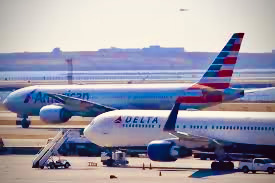 passengers +crew had just been cleared for takeoff. While an American Airlines Flight 106, a 777-200ER headed on a daily New York-to-London trip with 137 onboard, was taxiing out, ultimately to line up behind Delta 1943 on Runway 4 Left at about 8:45 p.m.. But that was where the tack turned.
passengers +crew had just been cleared for takeoff. While an American Airlines Flight 106, a 777-200ER headed on a daily New York-to-London trip with 137 onboard, was taxiing out, ultimately to line up behind Delta 1943 on Runway 4 Left at about 8:45 p.m.. But that was where the tack turned.
Misdirection Misplay.
Left, right, left, right? Wrong. But no sparing the details:
According to airport tape transcripts, Kennedy Ground Control had instructed A/A 106 Heavy (large) to depart the gate, beginning a counter-clockwise taxi route from the Tango Alpha (TA) intersection, paralleling Runway 31 Left to Taxiway Bravo, then hold short of Kilo. At the time, Delta 1943 was waiting to takeoff on Runway 4L, which happened to intersect 31L roughly one-third the way down.
A/A 106 had been directed by Kennedy Tower to turn right and cross 31L at Taxiway Kilo to Juliet, en route to takeoff on 4L. That was precisely where Delta 1943 had just been cleared by Kennedy Tower Control for departure, pilots pushing throttles to full power.
Problem was, the American 777 crew did not turn right to cross 31L as directed, despite having ‘rogered’ 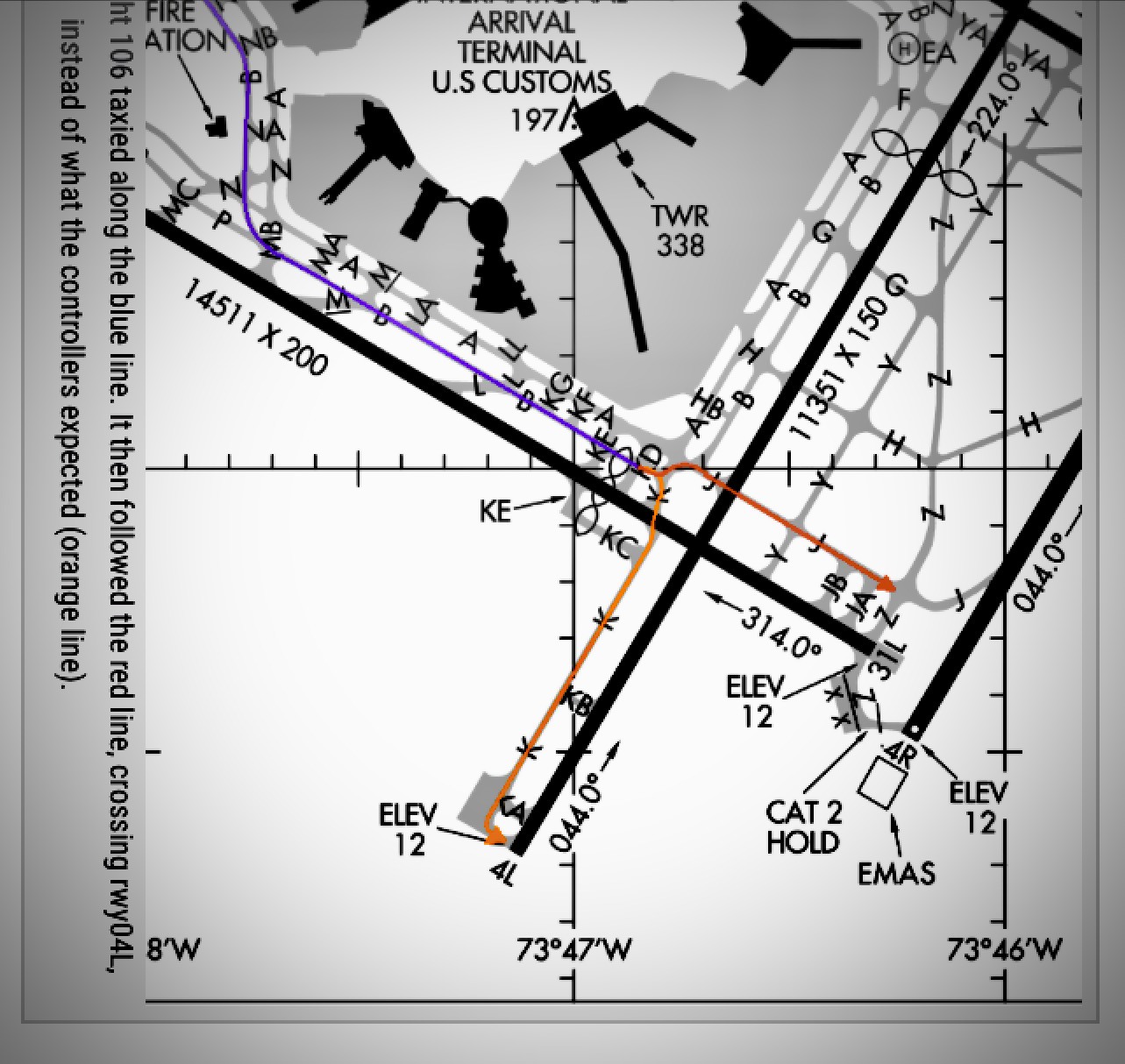 to do so. Instead, A/A 106 bore left, then right so as to head straight across 4L in front of Delta’s speeding 737, according to FAA officials. “Oh, shit,” screamed tower ATCs as they spotted A/A 106’s ‘possible pilot deviation’ (i.e., blunder), albeit with the assistance of a tracking system that detects/displays aircraft and ground vehicles on JFK taxi/runways. Thus controllers urgently ordered the 777 to ‘hold position’ on Taxiway Kilo, Delta to ‘cancel takeoff clearance’ on 4L.
to do so. Instead, A/A 106 bore left, then right so as to head straight across 4L in front of Delta’s speeding 737, according to FAA officials. “Oh, shit,” screamed tower ATCs as they spotted A/A 106’s ‘possible pilot deviation’ (i.e., blunder), albeit with the assistance of a tracking system that detects/displays aircraft and ground vehicles on JFK taxi/runways. Thus controllers urgently ordered the 777 to ‘hold position’ on Taxiway Kilo, Delta to ‘cancel takeoff clearance’ on 4L.
Though nearly reaching V2 ‘rotation’, the 737 had just enough runway before it to ‘reject’ clearance by reversing thrust and braking, then aborting to a ‘safe stop’. As for A/A 106’s crew, who apparently thought they had heard and affirmed tower commands properly, were corrected and advised by controllers that they were in violation of FAA rules. Still the 777 was soon cleared to depart for London from Runway 4L almost as if nothing that hazardous had occurred, while Delta 1943 and its passengers needed to layover at JFK until morning, ostensibly due to staffing shortages.
So close, but no rites and flowers. Still, let investigations begin: The National Transportation Safety Board has already landed to take flight crew and Kennedy Tower ATC statements, pore over flight recorder data on this latest potential ‘runway incursion’. One hitch—the planes’ ‘black boxes’ only hold two hours of recordings, and American 106 logged seven hours to London, with much of the flight’s JFK data likely overwritten. Reason enough why NTSB officials have long been prodding the FAA to boost flight recorder capacity to 24 hours.
In any case, given this chilling episode, one can’t help but reflect upon what continues to be the most fatal of such runway incursions—all the way back to 1977: 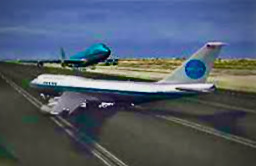
The Tragedy of Tenerife.
On March 27, two Boeing 747s collided on the runway of Tenerife’s Los Rodeos Airport in the Canary Islands. KLM Flight 4805, in takeoff mode, crashed into Pan Am Flight 1736, which happened to be on the same foggy runway—killing 583 passengers (KLM 248; Pan Am 335). As per this simulation ⇒
The Pan Am crew, suddenly spotting KLM’s landing lights racing toward them, attempted to veer their aircraft off the runway onto shoulder ground. Flight 4805, seeing 1736 far too late, tried in vain to lift off, but its landing gear clipped Pan Am’s fuselage and tail. Struggling to gain altitude, the KLM jet 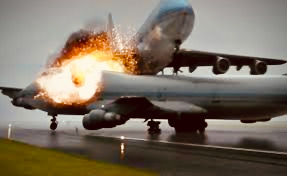 crashed into a fireball, its engines choking on 747 debris.
crashed into a fireball, its engines choking on 747 debris.
Subsequent investigations concluded that a bomb set off earlier (+ further threats) by some Canary Islands Independence Movement had forced the regional airport to close its four small taxiways, narrowing flight ground traffic capacity to that single runway. Contributing as well was the KLM captains’ mistaken belief that his flight had been cleared for takeoff—allegedly resulting from radio/language miscommunication between his crew and ATC, but KLM Airlines eventually took responsibility.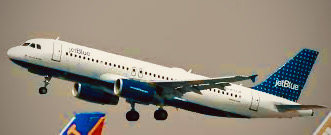
The Canary Islands crash remains the deadliest in aviation history. Then again, we’ve come a long way since those paleo-primitive days, right? Go ask the flight crew of a JetBlue plane off to Puerto Rico, which nicked a neighbor jet as JB taxied out from its JFK gate—just like it was yesterday. Because it was. (MTC…) ![]()
Failsafe, Not Faalure Sorry?
Update (2/16/23)—The FAA has since announced changes in its NOTAM alert/notification system maintenance designed to safeguard against the January 11 outages, which stalled some 11k flights nationwide over a massive, nearly two-hour breakdown. ☟
On an administrative level, the NOTAM system, which runs independently from the FAA’s air traffic control function, will be elevated from (lower priority) mission-support to safety-critical status. Further adjustments are said to involve adding a one-hour delay in linking time to keep any corrupt files or erroneous changes/deletes from interfering with backup databases, when techies are working to synchronize primary and backup DBs. Beyond that, at least two technicians (likely contractors) will be assigned to these computer hardware/software procedures, including one federal manager going forward.
The agency further explains that its NOTAM system currently comprises two conjoined components, a 30 year-old legacy unit (incl. “vintage hardware” to be discontinued by mid-2025) and its Federal unit (FNS), which has been undergoing upgrades since 2019, to be completed by 2030.
But an impatient airline industry is pushing for a speedier revamping of the entire agency, blaming a lack of resources and calling for significantly more stable and predictable Congressional support. In response, the House has passed legislation ordering the FAA to form a taskforce of its administrators, plus airport, airline, labor union representatives and aviation safety/cybersecurity experts—charged with improving, advancing alert and other agency systems, targeting a ’safety summit’ for March. Alas, there have been no Capitol Hill guarantees necessary FAA funding is forthcoming.
So we’ll see if the new NOTAM guardrails and ‘Lifeboat’ redundancy are notification of overdue modernizations to come–of a system described by Acting FAA Administrator, Billy Nolen as “…the safest, most complex…efficient ever.” Or this is yet another aviation agency ‘close-call’ but ‘near miss’. (MTC…)
![]()
FAAlure: A NOTAM Logjam.
(1/12/23)—Hot on the tail flaps of the Federal Aviation Administration’s Air Traffic Control system breakdown in Florida—freezing airspace, shackling the state’s airports and forcing long flight delays—comes another widespread malfunction.
To rehash: Last Tuesday afternoon, FAA technicians detected a glitch in its Notice To Air Missions system (NOTAM), which in short time was evidently addressed. By late Tuesday into overnight 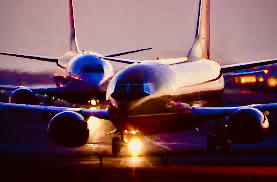 however, the flaw reappeared—essentially threatening an alert/notification service depended upon by pilots throughout US commercial, military and general aviation.
however, the flaw reappeared—essentially threatening an alert/notification service depended upon by pilots throughout US commercial, military and general aviation.
So alarming was the problem that by 5 a.m. EST Wednesday, the agency had decided to shut down its entire system—within the hour ordering a ‘ground stop’ of all departing aircraft nationwide, not least major airline flights. Planes were idled in place; boarded passengers deplaned from tarmac torture to terminal trauma, back through airport gates already packed to the waiting areas and checkpoints, shlepping through befuddled pre-boarded travelers—virtually all of them information starved, with nowhere else to go.
Particularly impacted carriers were Delta, American and Southwest (re: double whammied SWA), most airlines offering to waive fare differences for passengers seeking a later flight change. But carriers were not on the hook for refunds and reimbursements to hundreds of thousands of customers this time, because the disruption was, as with severe weather, ‘beyond carriers’ control’, at least according to Transportation Department regulations.
What the FAAck?
In any case, the ‘ground stop’, first since 9/11, logged some three hours, curbing nearly 25k flights coast to coast—cancellations and delays (CanDels) mounting, festering on. The GS directive was lifted by 9 a.m. EST, 1,300 flights having been scratched, nearly 9k stalled, leaving a scheduling ‘lagjam’ that could continue into this weekend, as carriers struggle to get planes in and out of overparked gates and slots. For all the while, aircraft landed safely, international flights to boot.
The NOTAM system provides constantly updated information pilots need before flying. These ‘must 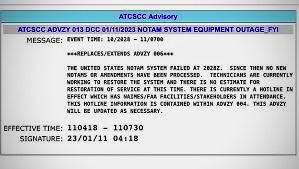 reads’ can run to 200 pages, alerting crews to radio frequencies, navigation restrictions, as well as wind/weather conditions, airport closures, taxi and runway obstacles that could affect flight plans, landing ability and scheduling in real time. Ground stop or no, federal regulations airlines require pilots to study these ‘reliable’ NOTAM notices before taking off—i.e., If NOTAM ain’t flowin’ we ain’t goin’.
reads’ can run to 200 pages, alerting crews to radio frequencies, navigation restrictions, as well as wind/weather conditions, airport closures, taxi and runway obstacles that could affect flight plans, landing ability and scheduling in real time. Ground stop or no, federal regulations airlines require pilots to study these ‘reliable’ NOTAM notices before taking off—i.e., If NOTAM ain’t flowin’ we ain’t goin’.
Turns out the ‘glitch’ was of FAA computer origin, the latest systemwide IT outage the agency has been quietly working through and around in recent years. Reports are its software engineer wrongly uploaded a corrupted data file during routine maintenance, prompting an agency plug pull, triggering a bad-data backup entailing manual alerts and inundating ATC phone lines, until the proper file was loaded and main NOTAM system restarted to full capacity.
Corrupted But Not Cyber Compromised?
Transportation Secretary Pete Buttigieg quickly defended the ground stop on safety/security grounds, also assuring that “…there’s been no direct evidence of a cyber attack”, but wouldn’t rule it out. He’s since made the media rounds insisting that a GS was the “right call”, citing “…irregularities in the alerting system that relays safety messages out to airports, aircraft and airlines (justifying the) halt to make sure NOTAM was working correctly…100% airtight.” Buttigieg (with President Joe Biden’s nod) said, “The 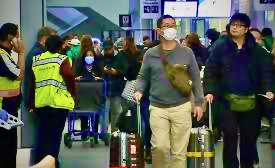 FAA will always act to make sure passengers are safe, (and that) now’s the time to review the agency’s aging technology.” Moreover “when there’s a problem with a government system, we’re going to own it…find it…and fix it…”—this particular one being an issue of “inconvenience, not safety.”
FAA will always act to make sure passengers are safe, (and that) now’s the time to review the agency’s aging technology.” Moreover “when there’s a problem with a government system, we’re going to own it…find it…and fix it…”—this particular one being an issue of “inconvenience, not safety.”
Yet critics beg to differ, left and right. Some aviation observers note that the single point failure of a damaged software file exposes an antiquated system in dire need of far further redundancy and updating. They accuse DOT and the FAA of failing to expend sufficient effort and resources to streamline the agency’s operations. Buttigieg counters that system/technology revamps take people, time and more money than Capital Hill has been willing to allocate for many years. Indeed, Congress’s latest transportation authorization (a $18.5bn) was leaner than 2004’s (inflation adjusted).
ALERT: Air Wars Ahead?
Legislators such as Sen. Maria Cantwell (D-WA) have now called for investigations into why the FAA is so vulnerable to disruption, adding that muted, inconsistent Congressional earmarks are no substitute for a more stable source of DOT/FAA funding. Detractors bemoan the troubled, woefully slow and costly rollout of Capital Hill’s two decade-old, multibillion dollar NextGen Air Transportation System to bring ‘Cold War-era’ FAA technology into the satellite and digital space age.
They further note that the FAA has not had a permanent agency leader since last March, as how the Biden 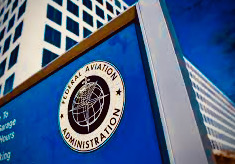 administration’s nominee has a somewhat shady background from his LA transportation days, predominantly why the Senate has his confirmation hearing ‘on hold’. Other grandstanders want Pete’s head, citing Buttigieg’s ‘in-apt FAA overreaction’ to the NOTEM snafu, replaying a brain-dead privatization shibboleth that had all but termed out with the Reagan administration.
administration’s nominee has a somewhat shady background from his LA transportation days, predominantly why the Senate has his confirmation hearing ‘on hold’. Other grandstanders want Pete’s head, citing Buttigieg’s ‘in-apt FAA overreaction’ to the NOTEM snafu, replaying a brain-dead privatization shibboleth that had all but termed out with the Reagan administration.
Still, with the spending authorization Congress passed in 2018 due to expire this year, surely many air campaigns and legislative battles will flare ‘roundtrip’ in the months to come—be they over DOT/FAA funding or the extent of aviation agency renewal.
So Vamigré will keep an eye to skirmishing skies, with the hope that airline passenger safety and service remain top of mind. And wouldn’t mind at all if the next Congressional payload arrives with the gravitas and urgency of a NOTEM notification, lest any other FAA snafus ensue. Meantime, let airline goodwill and generosity take flight before our skeptical eyes. (MTC…)
Also: Recent Near Misses at JFK and EWR +…
![]()
____________________________________
Bonus: THE INCREDIBLE SHRINKING MODES. ✈️
Intro: Shrink Wrap.
Banking toward matters of airline capacity, we see it doesn’t take a board certified shrink to diagnose notable changes in travel patterns and directions these post-pandemic days.
People work more flexibly, smartphone it in remotely, legions of retiring VamoSilvers are growing and going all the more. So while travel remains robust into the peak spring/summer season, the hidebound ‘when and where’ clotting and cattle calls are finally beginning to volplane. Increasingly tech-fed travel consumers are booking trips earlier and more strategically often. And with carrier change fees easing, we are making last-minute (‘plan B’) bypasses/redirections more frequently.
Airlines are certainly taking note, adjusting flight capacity accordingly. Case in point: current TSA stats do indicate a 14% drop in Tuesday and Wednesday traffic, but steadily stronger rebounds Thursday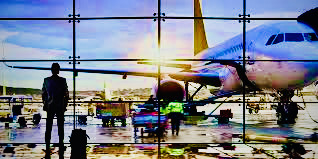 through Monday. So carriers such as Delta and Frontier are reportedly cutting flights by some 20% midweek, then hiking fares for peak-day flights—calibrating, if not throttling capacity, then overstuffing scheduled planes. This, while certain low-costers ‘ghost’ (scrap) their flights by the hour and day, leaving passengers in terminal no-go limbo.
through Monday. So carriers such as Delta and Frontier are reportedly cutting flights by some 20% midweek, then hiking fares for peak-day flights—calibrating, if not throttling capacity, then overstuffing scheduled planes. This, while certain low-costers ‘ghost’ (scrap) their flights by the hour and day, leaving passengers in terminal no-go limbo.
In all, airlines call it adjusting to a ‘new normal’ of further-out booking, close-in switching. They claim that these emerging pattern shifts threaten to further dent their load-factor and revenue projections, at a time when crew strikes, fuel spikes and ground labor shortages pose stiffening headwinds. Not to mention Biden Administration pro-consumer jawboning, and the judicial quashing of the JetBlue-Spirit merger and JB’s Northeast Alliance arrangement with American Air: Both verdicts on the forceful Department of Justice actions are pending appeal.☟
Nevertheless, Vamigré once again sees airlines rather shrinking fleets to fit their bottom lines, fixin’ to cause beset travelers more fits. So track, we will. But that’s the latest shrink rap/wrap for starters…
![]()
☟ HAWAIIAN AIR RAID?
(12/7/23)—With winter months scrolling onto its touch screens, Alaska Airlines has announced that it is warming up to Hawaiian Airlines in an ardently acquisitive way.
The Seattle-based carrier seeks to purchase the Sandwich Islands’ principal airline for $1.9bn from Hawaiian Holdings, Inc., stressing that the merged airlines would continue flying their separate brands and colors as they combine to increase their slice of Hawaii’s some $8bn annual passenger revenue pie –also expanding routes to Asian markets beyond.
Alaska’s CEO, Ben Minicucci contends that the consolidating airlines, long rivals, would become the lead dogs and dolphins to Hawaii, what with relatively little overlap (3%) in their respective route maps from major West Coast cities, and compatible aircraft fleets numbering 365 planes. The ‘great fit’ merger would allegedly better serve consumers with more flights to more Pacific destinations. And travelers would not be losing a budget airline in the process—which would take many months to implement at best.
Further, the “step change” purchase would enable Alaska Air to solidify its position as the nation’s fifth-largest carrier, and more effectively challenge the dominance of American, Delta, United and Southwest Airlines—which currently control nearly 80% of the domestic market.
As for Hawaiian Airlines itself, the carrier apparently welcomes Alaska’s lifebuoy, however lukewarmly. Because the Islands have faced a stream of challenges post-COVID: Namely slow visitor/revenue recovery, growing competition from SWA, aircraft delivery delays, and Maui’s wildfire devastation—to where Hawaiian Air has suffered net losses over 14 of the past 15 fiscal quarters.
Also factoring in is the reality that domestic (‘revenge’) travelers have been ranging increasingly international these days—another reason why Alaska’s Minicucci sees the deal offering a “tremendous 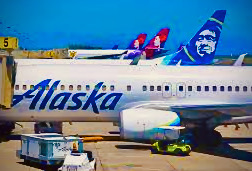 amount of upside” all around.
amount of upside” all around.
Upside Downsides.
Still, there is something of a chill in the air over this entire palmy arrangement—and how it actually threatens to reduce price/service competition in the mainland-to-Hawaii sector by boosting combined market share to nearly 40%, double that of the next entrant, UAL.
This, while the federal Department of Justice continues to look askance at such airline industry consolidation (e.g., majors gobbling up smaller players’ planes and gates/slots), already filing suit to block JetBlue’s own ‘existential’ takeover of low-cost carrier, Spirit Air for $3.8bn—just after scuttling JB’s East Cost partnership with American Airlines. A federal judge in Boston is expected to rule on that Spirit acquisition in coming days, with vigorous industry competition and price-conscious traveler concerns holding in the balance. ☟
At any rate, it can be argued that the larger an airline becomes, the higher its fares/fees rise, the more flight selection/service decreases and seats/storage shrink in kind—revenue/profit margins never deemed profitable enough. Then there is the less-is-more specter of anti-competitive and consumer ‘harming’ hub/route monopolies, not to mention potential price-fixing collusion with impunity.
It appears only the federal courts, Justice Department (+ FTC) stand in the way of further airline consolidation—Anti-Merger Act of 1950, pandemic bailout leverage, union demands notwithstanding. So we may see a clearer touch screen on the JetBlue-Spirit case by mid December at the latest.
For their part, Hawaiian Holdings investors will likely be voting on the merger deal early in 2024. Meantime, Alaska Airlines basks in the glowing prospect of greater Island access and bountiful aloha spirit, even though Hawaiian air-raid sirens may instead be blaring in early-warning mode. (MTC…)
PLAYING SOME SPIRITED JETBLUEs.
(10/31/23)—The US Justice Department has now pressed a federal judge in Boston to block the pending JetBlue-Spirit Airlines marriage, after filing an antitrust suit to throw wet rice on the entire $3.8bn affair—determining it to be ‘against the public interest’. Attorney General Merrick Garland had concluded that a merger of two ‘budget’/ULC rivals would result in reduced competition and increased prices, putting “… travel out of reach for many cost-conscious travelers”: Namely via a 30% fare increase on the combined routes, according to JetBlue’s own projections, costing passengers upwards of $1bn in harm per annum.
Scarcely helping the carriers’ case is that JetBlue’s aggressive, if not hostile attempt at creating the fifth largest US airline by 2024 (wishful thinking?), had already rankled federal regulators by forging a cozy 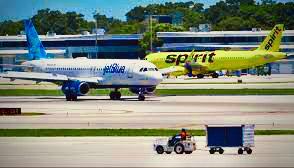 Northeast Alliance with American Airlines to more easily reserve/sell one another’s seats. Add in rumors that any newly merged JetBlue flights would offer fewer economy class seats (wow, that’s the Spirit!).
Northeast Alliance with American Airlines to more easily reserve/sell one another’s seats. Add in rumors that any newly merged JetBlue flights would offer fewer economy class seats (wow, that’s the Spirit!).
(Update 5/20/23)—A federal judge has since struck down that Northeast Alliance as a non-competitive ‘back-door’ merger in the making—a consolidating, cross-feeding partnership of heretofore fierce rivals that would stifle East Coast competition and raise fares, potentially costing travelers hundreds of millions of dollars per year.
The proposed major airline merger itself, which would have been the first in the US since Alaska’s takeover of Virgin America in 2016, aimed at landing 10% of the domestic commercial market. JetBlue holds that it is truly a ‘bargain’ brand, lowering fares in whatever market it has entered, to more or less ‘disrupt’ the legacy carriers.
But DOJ countered that Spirit is really an ‘ultra low-cost’ (ULC) airline, (albeit via higher fees), that frequently takes on the majors in their own markets nationwide. That JetBlue hews more toward Big Four domination, and the merger would seriously dull Spirit’s feisty competitive edge—not least along the East Coast, connecting down to the Caribbean.
New York, Massachusetts and District of Columbia have joined the Justice Department suit, as since have Connecticut, New Jersey, Maryland, North Carolina and California. So absent any negotiated resolution, brace to see them in court, and over the long haul, to be sure. (MTC…)
(10/20/22)–The final draw: All along, Spirit Airlines essentially played fellow discounter Frontier Group Holdings Inc. as a hole card to keep an already ‘blue-chipped’ JetBlue anteing up—no matter how the principals now spin it.
✈️ After months of bitter public haggling, four voting delays, Spirit investors trumped the carrier’s own board and handed its craven yellow jets over to JetBlue for a pot-busting $3.8bn cash. Once Frontier folded—standing pat and refusing to overbid beyond its $2.9bn cash-and-stock offer—JetBlue swooped back in, heaping planeloads of greenbacks on disSpirited stockholders to seal the deal.
The new, ostensibly conjoined carriers say their marriage, now fully shareholder approved, will be consummated by the second half of 2024, launching operations as the fifth-largest US airline (w/10% of the market) early in 2025. But that flight plan hangs on Justice Department regulatory approval of the merger, which is no pat hand given DOJ’s vigorous opposition to a current JetBlue-American Air Northeast Alliance (NEA) partnership, amid Biden administration antitrust concerns.
If, as Frontier has predicted, regulators nix the JetBlue-Spirit sale as being anti-competitive in an already over-concentrated airline industry, JetBlue will still owe Florida-based Spirit $70m and its shareholders a $400m ‘reverse breakup fee’. Either way, JetBlue will also be paying Spirit a monthly 10¢ per share ‘ticking fee’ from January 2023 until the deal fully closes.
Winner’s Losing Hand?
JetBlue’s blue-sky projections aside, the New York-based airline faces a long uphill slog to regulatory rice and bouquets. Industry analysts view its Spirited splurge a desperate move by an antsy higher-end budget carrier in dire need of precious pilots and more Airbus A320 aircraft—one now entering into  years of swampy cross-cultural integration with a spotty banana yellow discounter like Spirit.
years of swampy cross-cultural integration with a spotty banana yellow discounter like Spirit.
For its part, jilted Frontier is perhaps better suited for a powerful lone-ranger role as lead cowpoke in rapidly growing ultra-low-cost carrier territory, with a “lot of runway ahead.” And fuller saddlebags at that, since it will receive $25m from Spirit for its merger-related troubles, and $69m more upon Spirit’s striking the deal with JetBlue or any other carrier over the next 12 months, for that matter.
In any case, those same analysts note that passengers are usually losers in such consolidation plays; moreover “…we have yet to see an airline merger in the US over the past 30 years that has been good for consumers, labor…or even for the cities and regions in which they operate.” We will see about that…
Otherwise, both Spirit and JetBlue, lowly 6th and 10th respectively in recent D.O.T. on-time performance ratings, have announced they would continue to operate independently with customer loyalty ledgers unchanged until this high-flying merger is officially cleared to land.
Until then, we’ll hold tight, flush with questions, seeing a bluffer’s bet that may well crap out before it actually wheels down onto the tarmac. (MTC…)
(7/15/22)—At a time when Spirit Airlines suffers a fiery landing gear touchdown in Atlanta, this was not the only iffy/heated landing the Florida-based ultra lowfare carrier is executing these days.
✈️ The latest development: Four of a kind beats a wait? Nominal bidding frontrunner Frontier Group Holdings Inc. has requested a pause (to July 15) in Spirit Airlines shareholders’ vote (yet again) to give Frontier more time to sell its “last, best and final” proposal to more skeptical investors. Spirit’s board has obliged, extending the vote deadline until July 27, publicly continuing to prefer the Frontier scenario. It is essentially the fourth delay in this months-long merger saga, which finds rival JetBlue relentlessly sweetening it ante (now up to $3.7bn cash plus a per-month prepayment dividend), gradually wearing down the pro-Frontier Spirit boardroom crowd by the day.
Frontier holds fast to its bid ($2.7bn cash/stock), with a wild card of reverse termination fees should the US Justice Department ultimately nix the merger on grounds of anti-competition. Cushier low-cost niche player JetBlue has upped its firm breakup fee to $400m, while Denver-based Frontier counters with a $350m fee. New York-based JetBlue maintains that its wing-and-prayer proposal offers a better chance of federal regulator approval, despite a DOJ suit to block JB’s partnering with American Airlines. Moreover, proxy-advisory firm International Shareholders Services (ISS) advises the Spirit board to accept the “clearly superior” JetBlue offer its has been rejecting for months now in favor of Frontier’s truer budget-to-budget carrier marriage and its likelier prospect of passing regulator scrutiny.
The Frontier CEO doesn’t exactly exude mountain man confidence by now, his carrier remaining “very far” from corralling enough Spirit shareholder voters to seal the deal. Yet committed Frontier stays (that’s the Spirit!), whereas JetBlue is “…ready to enter a binding agreement with Spirit as soon as practicable…immediately following Spirit shareholders voting against the Frontier (bid) on July 27.”
Pot’s Right?
The increasingly bitter bidding gamble has been poison to both JetBlue’s and Frontier’s stock prices, but the Spirit jackpot—and it unifying promise of instant 5th largest Big Air carrier status—appears to be a payoff too ski high to pass up or eventually fail. So, very public negotiations and advertising campaigns aside, two questions obtain after all these months:
Is JetBlue’s aggressive obsession with ultra lowfare Spirit Airlines coming out of strategic vision/ strength or fiscal, existential desperation? Conversely, will Frontier’s quieter, stand-pat strategy prove to be its last merger rodeo?
We travel consumers will soon discover whether a New York takeover artist or Colorado cowboy justice will at long last win this Spirited aerial showdown, and what it will mean to us. Nevertheless it is looking to be a bumpy, if not fiery landing either way. (MTC…)
(6/2/22)—Now look at what the Jet Stream Blue in: a $3.6bn counter offer for Spirit Airlines in a bid to expand its fleet and fly with the Big Four (namely American, United, Delta, Southwest= 66%+ of market).
✈️ Make that an all-cash lure (continuing to be rejected by Spirit Airlines, which cited thoroughly ‘unacceptable’ regulatory risk—leaning back toward Frontier’s offer as a better low-fare fit. JetBlue differs, so let another shareholder vs. seatholder battle begin):
Next step, JetBlue launches a hostile takeover ’tender offer’ directly to Spirit shareholders at $30 per share, $3.2bn total…nevertheless, Spirit’s board continues to urge rejection of JetBlue’s “risky…cynical” bid. But JetBlue keeps sweetening the pot, offering a higher ($3.4bn) deal, with an (anti-trust) breakup fee of $350m, prepaid as a shareholder dividend. Frontier stands pat (incl. a $250 breakup fee), and Spirit’s board members suggest they will play their hand later this month. Again, JetBlue’s aggressive bidding is meant to occlude the Frontier-Spirit merger plan announced in February☟—which was seen as forging a rival ultra-low-fare (U.L.C.C.) giant with compatible fleets of Pratt & Whitney-powered Airbus A320s. Affording cheap fares, albeit with minimal service and fees for select seating, checked bags and most everything else, that combined airline would supposedly comprise 10% of the domestic market and save passengers $1bn per year.
However JetBlue cites its “superior proposal”: a larger, more powerful challenge to the Bigs, grabbing some 8% of the US market while also bringing fares down. Such a “perfect match” with budget carrier Spirit would boost its fleet to 450 mainly Airbus planes—by retrofitting some Spirit aircraft—with 300+ more ordered over the next six years.
Primarily a domestic US carrier, New York-based JetBlue could gain system range, given Florida-Based 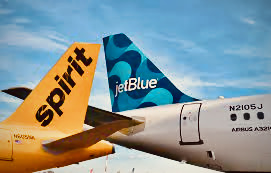 Spirit’s routes along the East Coast, legacy hubs west (Memphis to Dallas) and across the Caribbean and Latin America. This marriage would presumably establish a formidable ‘Fifth Major’ in market share (adding in JetBlue’s current coordinating ‘de facto merger’ arrangement with American Airlines), ostensibly offering low fares and “a greater travel experience.”
Spirit’s routes along the East Coast, legacy hubs west (Memphis to Dallas) and across the Caribbean and Latin America. This marriage would presumably establish a formidable ‘Fifth Major’ in market share (adding in JetBlue’s current coordinating ‘de facto merger’ arrangement with American Airlines), ostensibly offering low fares and “a greater travel experience.”
Not Surprisingly, Frontier (and its $2.9bn offer) argues that it and Spirit share more complementary bargain-fare, point-to-point business models in distinctly different regions. The Denver-based carrier paints JetBlue’s bid as creating East Coast overlap that would actually decrease competition, resulting in “more expensive travel”, since JetBlue is a decidedly higher-fare carrier known for its lie-flat beds seating, free Wi-Fi and full-serve meals, at least in premium business class.
Spirit itself has simply said the “unsolicited” JetBlue offer would be evaluated “…in the best interests of Spirit and its stockholders” within 10 business days—with of course little or no regard for us travelers. It also must be said that JetBlue is playing all sorts of hardball cards, not least filing ‘Vote No’ proxy statements to Spirit shareholders to reject the Frontier offer, while slinging mud at Frontier’s controlling management and Spirit’s board member ties with private equity outfit, Indigo Partners.
As to all that, Wall Street and most airline industry analysts quickly red-flagged the confounding, ‘out-of-the-Blue’ bid—skeptical that either merger would actually deliver as promised—none of the three carriers playing a particularly strong hand. For a time, JetBlue and Frontier shares were down some 8%, Spirit itself down over 3% before bouncing back. Clearly, these consolidation plays come amid a post-pandemic scramble for pilots, flight attendants and staffers as travel demand rapidly rebounds.
But whether the Department of Justice antitrust regulators climb aboard is another matter, since the Biden administration has already nixed the proposal for a more formal “Northeast Alliance” between American Airlines and…JetBlue.
Seems like more than ATC snags and congestion are affecting the overcrowded Florida skies these days. So will it be ‘pass the Spirits’, ‘thar she Blues’, or a rather expansive new Frontier? We still shall see…(MTC…)
☟CROSSING A DiSPIRITING FRONTIER?
(2/8/22)—If it’s not a flight, it’s a fleet. If it’s not a scheduling purge, it’s a carrier merge: Yet do two negatives make a positive?
Frontier and Spirit say positively, roger that, as the super low-cost airlines announce their plans to join forces, doubling down in a $6.6bn deal, essentially creating the nation’s fifth largest US carrier overnight. They would thereby be offering 1,000 daily flights to some 150 destinations in the US, Caribbean and Latin America. Even though their merger fanfare did face a rather inauspicious takeoff, with 130+ of Frontier’s flights and 25% of its operations being same-day grounded by a system-wide technical breakdown (said to be ‘quickly fixed’).
Nevertheless, Colorado-based Frontier is set to become the purchasing partner (51.5%), buying Spirit for $2.9bn in cash and 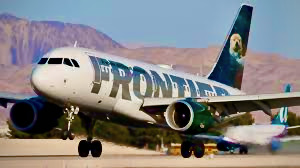 stock. It brings its Western states network to the marriage, while Florida-based Spirit provides broader Eastern US coverage and more international routes. Both carriers fly only Airbus A320 series jetliners, fleets expecting to grow from 280 (combined) to upwards of 500 by 2026.
stock. It brings its Western states network to the marriage, while Florida-based Spirit provides broader Eastern US coverage and more international routes. Both carriers fly only Airbus A320 series jetliners, fleets expecting to grow from 280 (combined) to upwards of 500 by 2026.
Targeted for a second-half 2022 close, this proposed fusion would vault ‘Frontier/Spirit’ past JetBlue and Alaska Air in terms of total miles flown by paying passengers, forging a giant budget carrier bested domestically only by the four biggies: American, Delta, Southwest and United—which control some 80% of the total airline market. It comes at a time when the three low-fare carriers (+ Allegiant) are rebounding more robustly from the pandemic downdraft (Q1 travel capacity per seat miles up 21-29% from 2019) than those lagging majors (down 16-18%). Because the leisure sector is surpassing business travel in passenger traffic lately—crammed coach seats faring better demand-wise than cushier first-class digs. Reason enough why their growth plans are soaring sky high.
No denying both airlines have suffered losses in the past two years. Spirit posted a $440.6m deficit in 2021 (federal assistance or no), after a far redder 2020 of $719.6m. Frontier lost 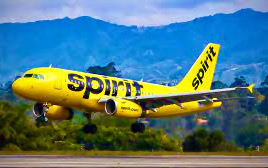 $299m in 2020 and 2021. Still, their respective CEOs claim their merger will yield an aggressive ultra low-fare competitor to the majors with more consumer-friendly fares, thereby “saving passengers some $1bn per year”) and affording better point-to-point service (e.g., to underserved smaller cities) in this booming leisure travel market. They say a combined Frontier/Spirit will also create 10,000 new jobs by 2026, with destinations and communities also benefitting—i.e., win, win all around.
$299m in 2020 and 2021. Still, their respective CEOs claim their merger will yield an aggressive ultra low-fare competitor to the majors with more consumer-friendly fares, thereby “saving passengers some $1bn per year”) and affording better point-to-point service (e.g., to underserved smaller cities) in this booming leisure travel market. They say a combined Frontier/Spirit will also create 10,000 new jobs by 2026, with destinations and communities also benefitting—i.e., win, win all around.
Then again, the two no-frills airlines bring dismal customer satisfaction ratings to the bargaining jetway. While both offer dirt-cheap base fares and minimal service, they routinely tack on extra fees for most everything else, not least carry-on bags. Spirit, which basically invented ‘ancillary revenue streams’, amassed the highest number of complaints (13.25 per 100,000 passengers) in Q1-3 2021, while Frontier rated 5.56 per, after a bruising 60.24 in 2020.
Little wonder merger critics fear a truer reality of this low-fare giant devouring smaller no-frills competitors—of fewer flights to fewer cities, with negligible service at higher fares and costs, particularly as passenger traffic increases come spring and summer.
Frontier Justice?
Ultimately the plan must first cross paths with a Biden administration that is prioritizing more competition in the airline industry. It notes this is the first such merger since Alaska Air swallowed up Virgin America in 2016, and such industry consolidation has resulted in the four major carriers shrinking from ten in the past 25 years. Which is perhaps why the feds aggressively blocked a recent American Air/JetBlue domestic ‘alliance’, and antitrust regulators will likely scrutinize the Frontier/Spirit merger plan all the more. This, despite the carriers’ assertion that a service overlap in merely 18% of their total routes limits the potential reduction of competition for passengers. And the combined airlines, currently ranked eighth/seventh respectively, will still only amount to 10% of the market overall.
At any rate, the Departments of Justice and Transportation will be the judges of that, as will the carriers’ respective pilot and flight attendant unions. And Vamigré will be crossing this new Frontier as well—if and when we should actually come to it. (MTC…)
SHRINK TO FITS.
(7/15/22)—Like cheap uni khakis on high spin dry, the shrinkage continues unabated, just as travel demand surges to fitful 2019 levels and beyond.
Most recently, and internationally: British Airways cut some 10,300 flights from its summer ’22 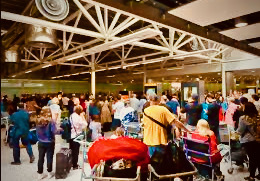 schedule due to capacity limitations: namely pilot and staffing (particularly tarmac/ramp workers) shortages. KLM Royal Dutch trims 2,000 scheduled flights, restricting ticket sales to acutely bottlenecked European destinations—Deutsche Lufthansa (2k cuts across the Continent), Air France and easyJet PLC following suit, with little public notice. Moreover, a pilots strike (1,000+) has so crippled debt ridden SAS AB that the leading Scandinavian carrier filed for Chapter 11 protection, under more favorable US conditions, for nine months to a year, cutting 50% of its scheduled flights per day.
schedule due to capacity limitations: namely pilot and staffing (particularly tarmac/ramp workers) shortages. KLM Royal Dutch trims 2,000 scheduled flights, restricting ticket sales to acutely bottlenecked European destinations—Deutsche Lufthansa (2k cuts across the Continent), Air France and easyJet PLC following suit, with little public notice. Moreover, a pilots strike (1,000+) has so crippled debt ridden SAS AB that the leading Scandinavian carrier filed for Chapter 11 protection, under more favorable US conditions, for nine months to a year, cutting 50% of its scheduled flights per day.
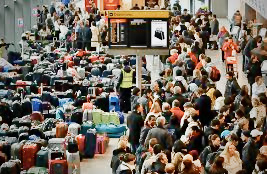 Seems at a time when inflation is hammering the euro, now on a 1:1 par with the US Dollar, travelers are attracted to relatively less expensive Continental destinations, even as historic heat and wildfires now rage across Europe. Yet more Euro flagships are unfurling by the day…to where London’s Heathrow airport is asking airlines to cap ticket sales (at 100k passengers per day) for the summer into September.
Seems at a time when inflation is hammering the euro, now on a 1:1 par with the US Dollar, travelers are attracted to relatively less expensive Continental destinations, even as historic heat and wildfires now rage across Europe. Yet more Euro flagships are unfurling by the day…to where London’s Heathrow airport is asking airlines to cap ticket sales (at 100k passengers per day) for the summer into September.
This despite stern rejections from carriers such as Emirates, which charges the airport management with incompetence (as in baggage backlogs—a colossal bag lag perhaps triggered by a June conveyor belt failure), underfunding and overall consumer disregard. While Amsterdam’s busy Schiphol Airport is little better off, having set its passenger limits on June 16. (MTC…)![]()
BAKED ALASKA?
(6/8/22)—The first conspicuous stress cracks in air travel’s projected 2022 rebound are currently cleaving Alaska Airlines.
For the Seattle-based carrier continues to be hit, and hit hard, by a searing pilot ‘work stoppage’ that has resulted in well over 550 flight delays/cancellations since May 1 and counting, waylaying tens of thousands of passengers, with no contract 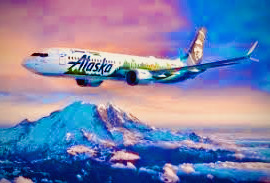 resolution on the horizon.
resolution on the horizon.
Over 3,100 Alaska Air pilots have forsaken their cockpits, some walking picket lines at Sea-Tac and other airports amid a nationwide commercial pilot shortage. The Airline Pilots Association union members have been locked in bitter contract negotiations with Alaska for three years, over issues of pay, job security and schedule stability. ALPA contends the carrier has not been bargaining seriously, and is attempting to blame pilots for its own mismanagement—not least its ‘half-baked’ systemwide preparation for a post-pandemic demand surge in air travel, which Alaska pilots say the company “should have seen coming all along.”
The carrier counters that a new pilot agreement is priority one, but “we must maintain growth and profitability for a strong future.” Claiming to have posted a meager $14m profit in Q4 2021 after $2.3bn in 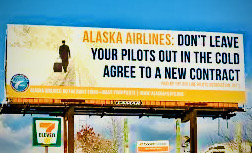 pandemic period losses, and now reporting a $143m Q1 loss (Wall Street projected $202m), Alaska Air still foresees improvement by June, even plans to boost its fleet by 100 planes to 400 overall, and hire 300 more pilots by year’s end.
pandemic period losses, and now reporting a $143m Q1 loss (Wall Street projected $202m), Alaska Air still foresees improvement by June, even plans to boost its fleet by 100 planes to 400 overall, and hire 300 more pilots by year’s end.
Where they expect to find them amid a pilot shortage lasting as long as seven years surely raises questions of competence and safety at the cockpit controls flying forward, as this isn’t simply a matter of crash courses or OJT. Moreover, more than 375 of the pilots Alaska has hired in recent months are from regional lines with experience solely on small jets or turboprops, while Alaska’s A320 or 737 training capacity is now limited.
Meantime, those contract negotiations are before a federal mediator, which have stalled to impasse thus far. So the carrier is offering a bonus 150% of pay for pilots willing to pickup extra flights—as it was short over 60 pilots in early April—admitting its ‘operational performance’ has been suffering, further impacted by harsh weather across the land. But ALPA warns its Alaska Air pilots are stressed and over stretched as it is, and that over 50 have been already been poached this year by other carriers promising better, easier working conditions.
This, while the airline’s customer service ranks are similarly thinned. Which means suddenly stalled or scrapped flights and up to ten-hour call center wait times, frustrated passengers being grounded, rerouted with last-minute flight-day notification or dished off to competing lines. So we travelers are taking the Alaska squabble and shortage in the shorts, if not contracting bouts of halting ‘terminalitis’, with more airline aggravation and inconvenience baked in by the day. And no amount of splashy “We Care” adverts seem to lighten that load.
Alas, Alaska Air may be the first major carrier stricken by pilot/crew and staffing shortages this spring, but quite likely won’t be the last: A distasteful vernal entrée, to be sure. (MTC…)
![]()
EVEN MORE INCREDIBLE SHRINKING MODES.
(5/16/22)—The inevitable post-holiday hangover portends an increase in fretful, untoward layovers well through early 2022.
To be sure, travel demand is down into the new year thus far—what with COVID-Omicron, rough winter weather and the usual January lull. And even leading US airlines are smarting from millions upon millions of dollars in Q4 2021 losses, only Southwest and Alaska Air eking out modest profits.
So rather than soaring forward anew into ’22, most carriers are scaling back. Overall, domestic airline seat 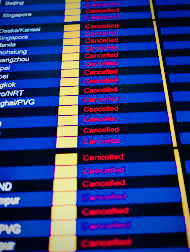 capacity is down some 12% over 2019, internationally off 52%. More specifically, Europe’s capacity is down over 42%—same for Asia, Africa and the Southwest Pacific—South America and the Caribbean upwards of 25%.
capacity is down some 12% over 2019, internationally off 52%. More specifically, Europe’s capacity is down over 42%—same for Asia, Africa and the Southwest Pacific—South America and the Caribbean upwards of 25%.
What these numbers add up to is significant fleet and schedule shrinkage, ‘proactive reductions’ in the parlance of one carrier, an industry wide trimming of seat sales. Take American Airlines (advisedly), which has cut thousands of flights through March, 1-6 runs per daily, out of six cities: New York, Miami, Chicago, Dallas, Phoenix and L.A. The Ft. Worth-based carrier cites, COVID/Omicron infections, winter storms, pilot shortages and fleet delivery delays, but insists it is not actually exiting the cities long term.
Chicago-based United is similarly paring its Q1 schedule, noting steeper labor and fuel costs (jet fuel up 122% of late) as well. Atlanta-based Delta is grounding hundreds of flights in February on, saying it continues to work together around the clock to reroute and substitute aircraft and crews.
JetBlue has cancelled nearly 1,300 flights through January, struggling to get crews back to work sooner, what with COVID cases and staff furloughs. The New York-based carrier is “proactively reducing” flights “with as much notice to customers as possible”—although some of its passengers report phone tree holds of up to five hours.
Even slightly Q4 profitable Southwest Air (Texas) and Seattle-based Alaska Airlines are cutting flight schedules between 10-15%. And these hairy capacity ‘hair cuts’ account for domestic air carriers alone. The only sliver of light on this horizon is the emergence of several scrappy low-fare start-ups, such as Breeze and PLAY Airlines, which seek a competitive edge via exclusively ‘differentiator’ apps and text communication. Alaska-based Northern Pacific, sister of Ravn regional line, plans to launch one-stop service between the US and northeast Asia (on 757s, with an Anchorage stopover) this summer. Meanwhile, Oslo-based Norse Atlantic Airways seeks 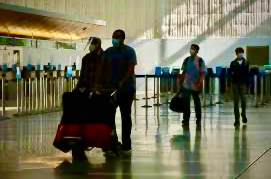 a foreign air carrier permit from the Department of Transportation to offer low-cost trans-Atlantic flights between California/Florida and Europe in coming months—routes recently ceded by Norwegian Air.
a foreign air carrier permit from the Department of Transportation to offer low-cost trans-Atlantic flights between California/Florida and Europe in coming months—routes recently ceded by Norwegian Air.
These newbies join Avelo Airlines, a Houston-based ultra low-cost carrier flying to a variety of heretofore ill-served domestic destinations out of Burbank, CA and New Haven, CT with a fleet of 737-700/800 aircraft.
Meantime, the majors’ widespread shrinkage leaves us travelers changing flights, itineraries, departure times, even hubs—if we are able to book a flights (particularly on non-stop routes) and board it at all. Moreover, as airlines adopt this less-is-more operational approach (e.g., easyJet is even stripping away available seat rows), we face the supply/demand conundrum of fewer choices at higher fares owing to arbitrarily limited flights, aircraft and crews.
The air travel squeeze is on, near term anyway. Reason enough why Vamigré will come to the lemon-aid in some potentially sour, if not fitful days ahead. (MTC…)
![]()
A/A to SWA, GOODWILL BLUNTING.
10/25/21—Whatever good terms and tidings took flight as pandemic travel restrictions loosened earlier this year were grounded this past holiday weekend as the world’s largest low-cost airline continued stranding thousands of passengers nationwide.
Over those past four days, Southwest Airlines cancelled over 2,300+ flights, delayed hundreds more, with no immediate relief in sight for travelers who have been lining up and camping out at airports coast to 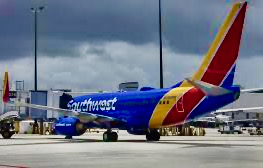 coast, desperately trying and paying dearly to change modes and plans—just like in the bad old pre-COVID days. The spiral of disruptions has cost (aggressively overreaching) SWA $75m in cancellations and exhausted its flight crews and staffs.
coast, desperately trying and paying dearly to change modes and plans—just like in the bad old pre-COVID days. The spiral of disruptions has cost (aggressively overreaching) SWA $75m in cancellations and exhausted its flight crews and staffs.
SWA attributes its latest schedule stripping (nearly 27% of its operational capacity) to foul weather and air traffic control problems plus pandemic-period staffing reductions—not least in Florida (hub to nearly 1/2 of its daily flights)—specifically citing a ‘hiccup’ at the Jacksonville Air Route Traffic Control Center. But the FAA counters that a few hours of military and staff training at the northern Florida facility caused no significant service disruption or air traffic control problems (e.g., affecting less than 2% of carrier operations for American and Spirit).
Instead the federal agency focus is on aircraft and flight crews being situated markedly out of place when the COVID travel slump ended with an unexpected explosion of pent-up summer demand. Southwest 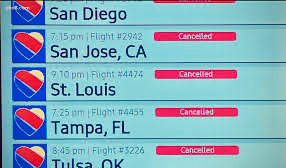 does concede that its fleet and staffing reductions throughout the pandemic via furloughs, buyouts and early retirement packages will make “…getting back to normal more difficult and prolonged,” said SWA Chairman/CEO Gary Kelly. But more schedule paring and capacity crunches may be in order to clear its operational skies, as most all airlines struggle to hire and/or rehire, retrain sufficient pilots and staff.
does concede that its fleet and staffing reductions throughout the pandemic via furloughs, buyouts and early retirement packages will make “…getting back to normal more difficult and prolonged,” said SWA Chairman/CEO Gary Kelly. But more schedule paring and capacity crunches may be in order to clear its operational skies, as most all airlines struggle to hire and/or rehire, retrain sufficient pilots and staff.
Jabs=Jobs?
Still, that doesn’t address the condor in the cockpit here, namely the Dallas-based airline’s recent mandate for companywide COVID vaccinations (or weekly testing) by December 8 (with certain exceptions)—no matter what anti-mandate executive orders come down from the Texas capital. Some headline-grabby politicos are already blaming the industrywide federal VAX directive for SWA’s current system breakdown, suggesting that a pilot walkout may be at work.
The Southwest Airlines Pilots Association (SWAPA) denies any such union stoppage as “false claims”, stating that its members are “…not participating in official or unofficial job actions”, rather ascribing the widespread cancellations/delays to poor company planning—as in overreaching route expansion during the summer travel rebound, scheduling more flights than they can operate. And to date, no other vaccine mandated carriers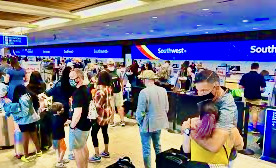 have so far reported commensurate crew and/or staffing shortfalls—although SWA is surely not the only airline to be facing such logistical meltdowns.
have so far reported commensurate crew and/or staffing shortfalls—although SWA is surely not the only airline to be facing such logistical meltdowns.
In any case, Southwest has already been weathering a quite difficult 2021, with the worst on-time performance and largest percentage of flight cancellations among the four major US airlines in June and July. At the same time its pilots, flight attendants (timing out of FAA allotted air hours) and mechanics—(let alone passengers)—have been complaining about the lofty budget airline’s downdraft and staffing cuts (some 7,000 fewer employees than in pre-pandemic times). Some assert that Southwest routing/operations have become “brittle and subject to massive failures under the slightest pressure”, what with out-of-position aircraft and tightly margined crews scattered, stranded to the winds.
An unsparing assessment to be sure, but given how bluntly the carrier is throttling the goodwill of its travel-hungry passengers, not exactly out of place thus far—absent some quick SWA qualitative pleasing and quantitative easing.
10/31/21—Southwest is not flying solo on this count, however, as the Utah-Based SkyWest regional airline had to cancel (463) and delay (900) more flights October 21-22 due to cascading “operational disfunction: i.e., its crews and aircraft were “out of position.” Now, et tu, American Airlines—cancelling nearly 2k flights over the Halloween weekend (12% of its operations), delaying nearly 30% of its entire capacity—citing, what else: foul weather (limited to 2 of 5 runways in windy DFW) and staffing shortages (of flight attendants and ground crews). Trick or mistreat? (MTC…)
